Best bike torque wrenches: Protect your components and improve your maintenance work
The best bike torque wrenches will ensure you can adhere to torque specifications and keep yourself and your bike safe
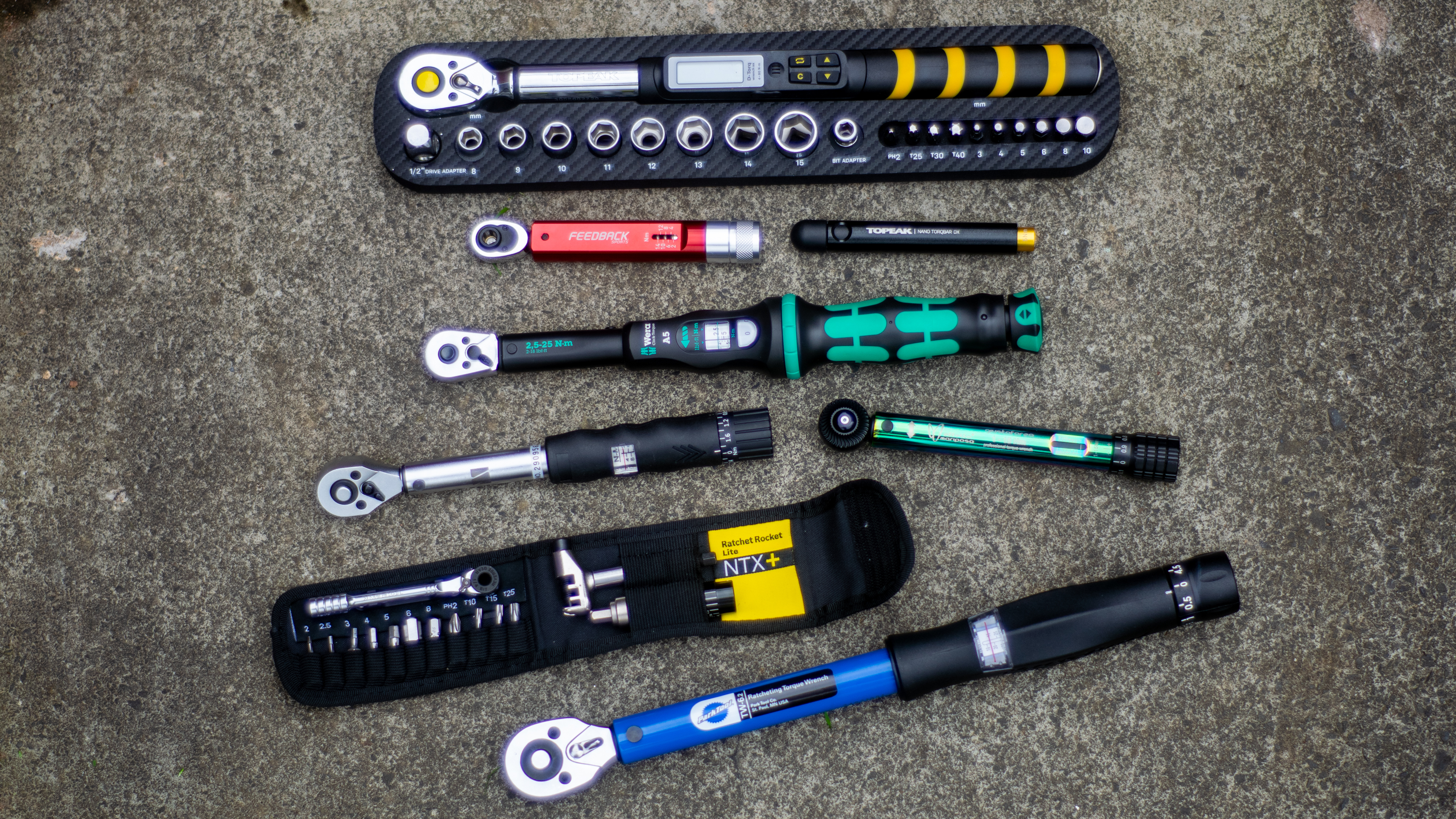
Working with a torque wrench can drastically reduce the chance of damaging any parts on your bike or having them come loose while riding. A torque wrench is a tool that allows you to tighten all the bolts and components on your bike to the manufacturer's recommended torque specifications.
Modern bikes and components all have specific torque ratings, and adhering to them can prevent damage, especially on modern carbon fibre frames and parts. Owning one will help you work on your bike accurately and safely, and even help you save money long term.
The best bike torque wrench will allow you to quickly and safely tighten your bike's fasteners or bolts to the correct torque spec every time. This helps protect the delicate and lightweight components that are now so commonplace on the best road bikes, as well as prevent a failure or mechanical issue whilst out on a ride.
I've done lots of research for this guide, which should help improve your torque knowledge and provide lots of useful tech info. I spoke with big manufacturers for torque tips and advice, chatted with bike, car and plane mechanics, and even took torque wrenches to a calibration lab to learn more about calibrating them.
Based on our testing, we think Pedro's Demi torque wrench is the best bike torque wrench. It's a compact, quality wrench that comes in a tool roll with a handy range of included bits. It works over a 3-15Nm range, so it will deal with most standard fasteners on a bike with ease.
For lots of buying advice and more info, head to the bottom of the page for my guide on how to choose and information on how we test.
Quick List: Best bike torque wrenches
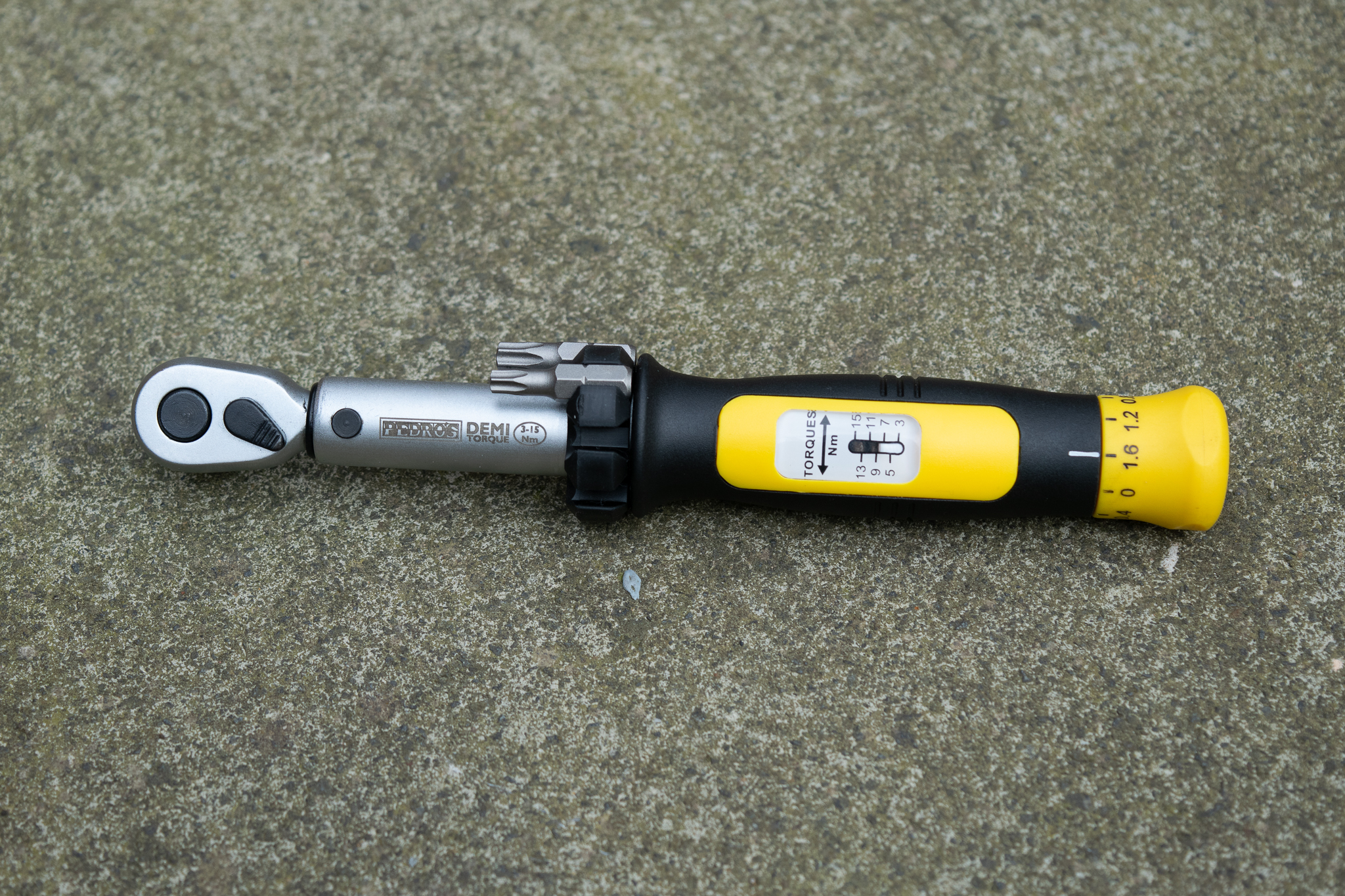
Pedros Demi torque wrench takes the best bike torque wrench top spot. It's a compact, high-quality torque wrench that covers most regular jobs required on a modern bike. The soft tool roll is easy to access and the included wide range of bits will let you do a lot.
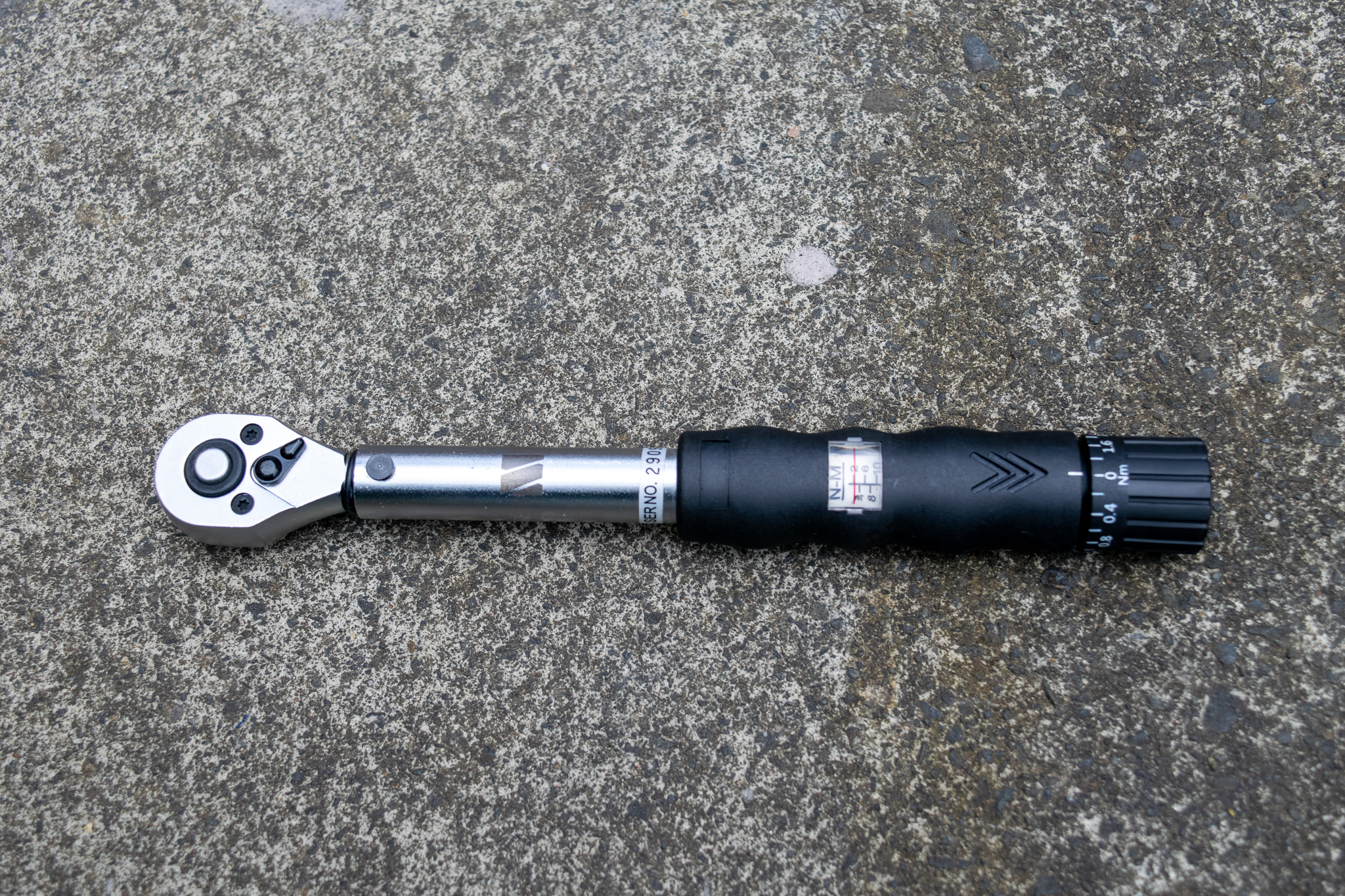
The M Part torque wrench is a great, budget-friendly option. It comes in a neat case and includes seven bits. This is a great budget torque wrench for home use.
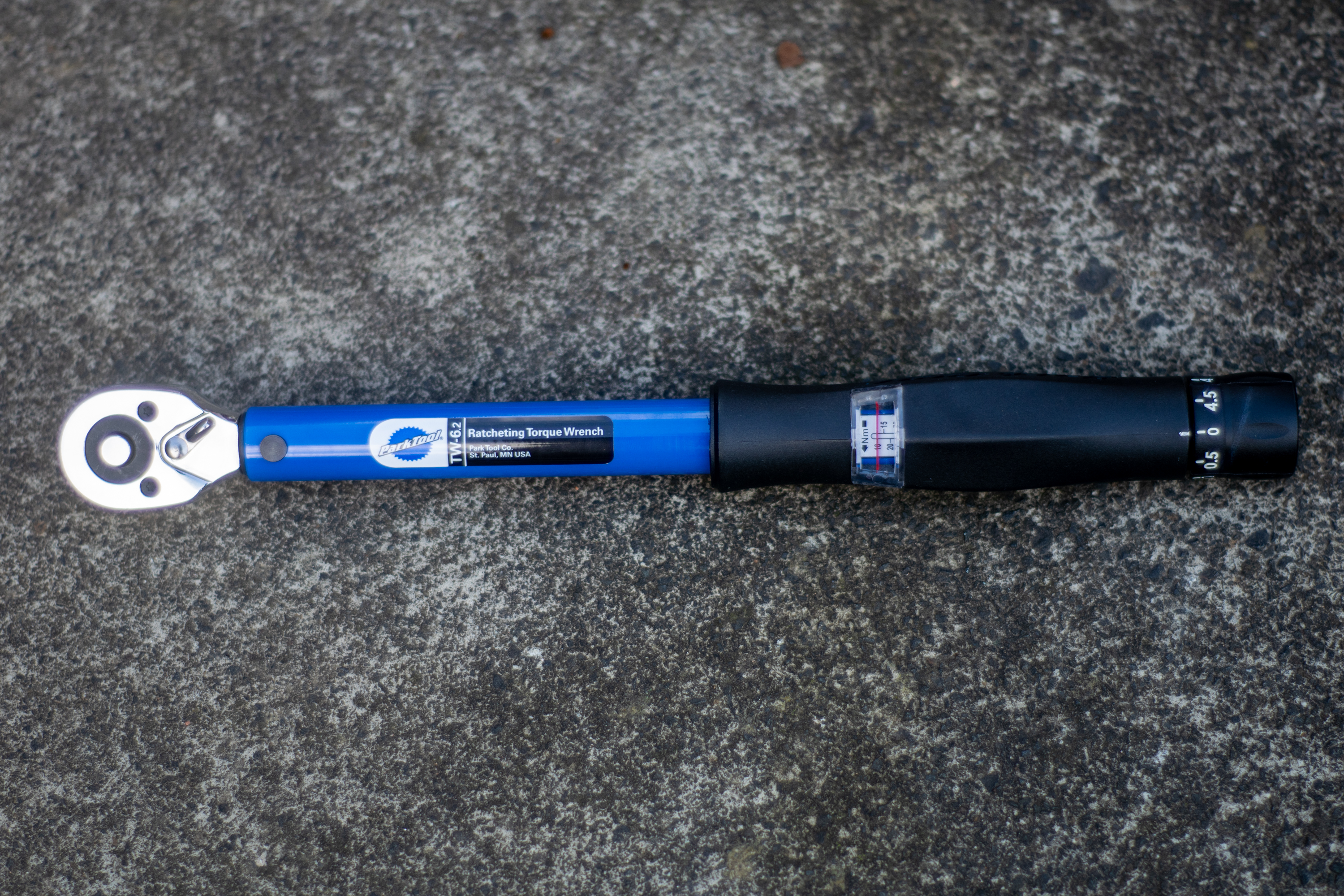
The Park Tool TW 6.2 is the largest and heaviest torque wrench in the test. It comes in a sturdy plastic case, and it has a hefty 3/8 square drive unit and a torque range of 10-60Nm. It's perfect for chainset bolts, cassette lock rings, or any higher-torque application.
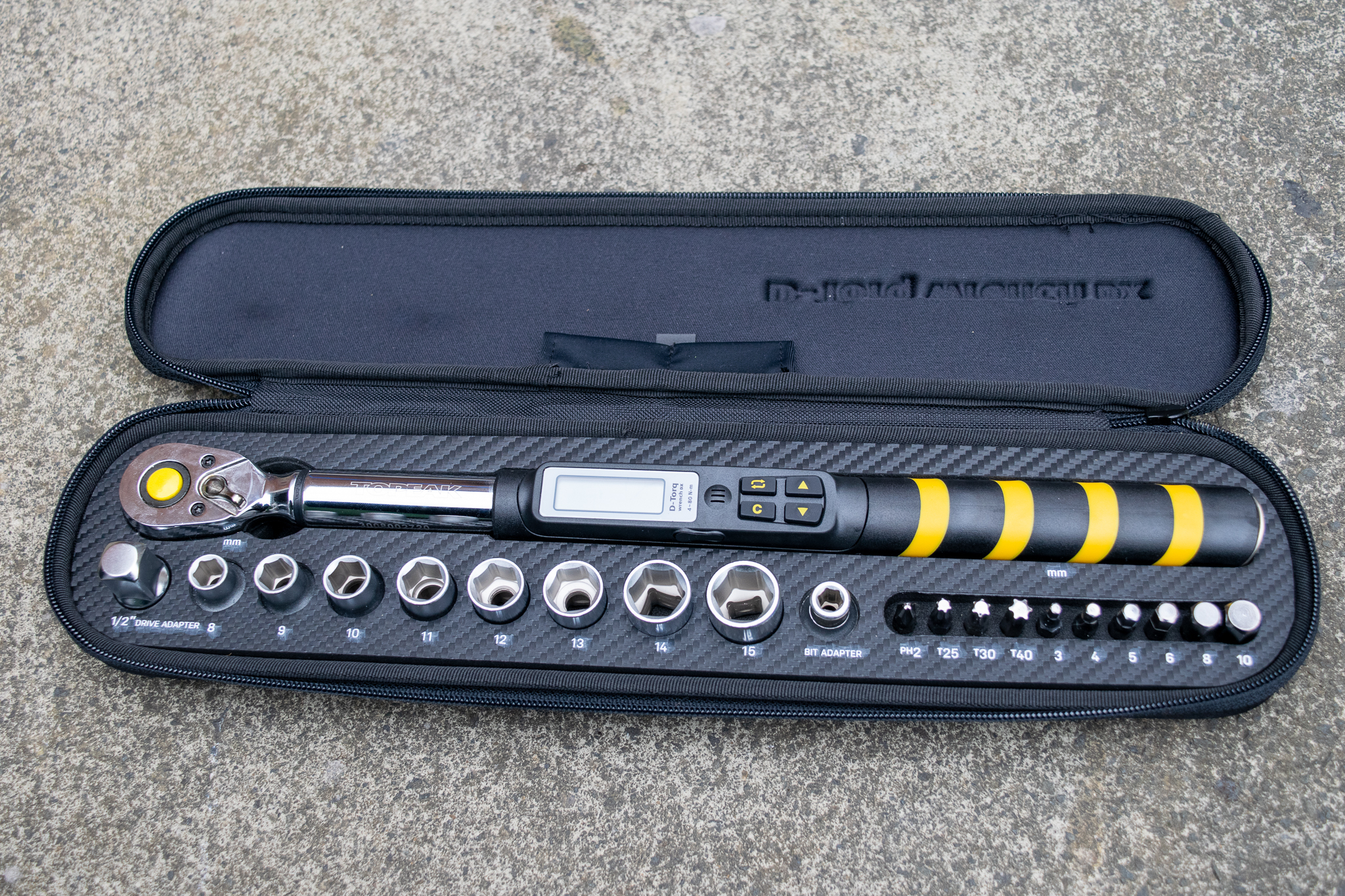
The Topeak D-Torq DX is an electronic torque wrench that comes in a smart case with a large range of included bits and sockets. It covers a 4-80Nm scale, meaning it can tackle pretty much every job on a bike.
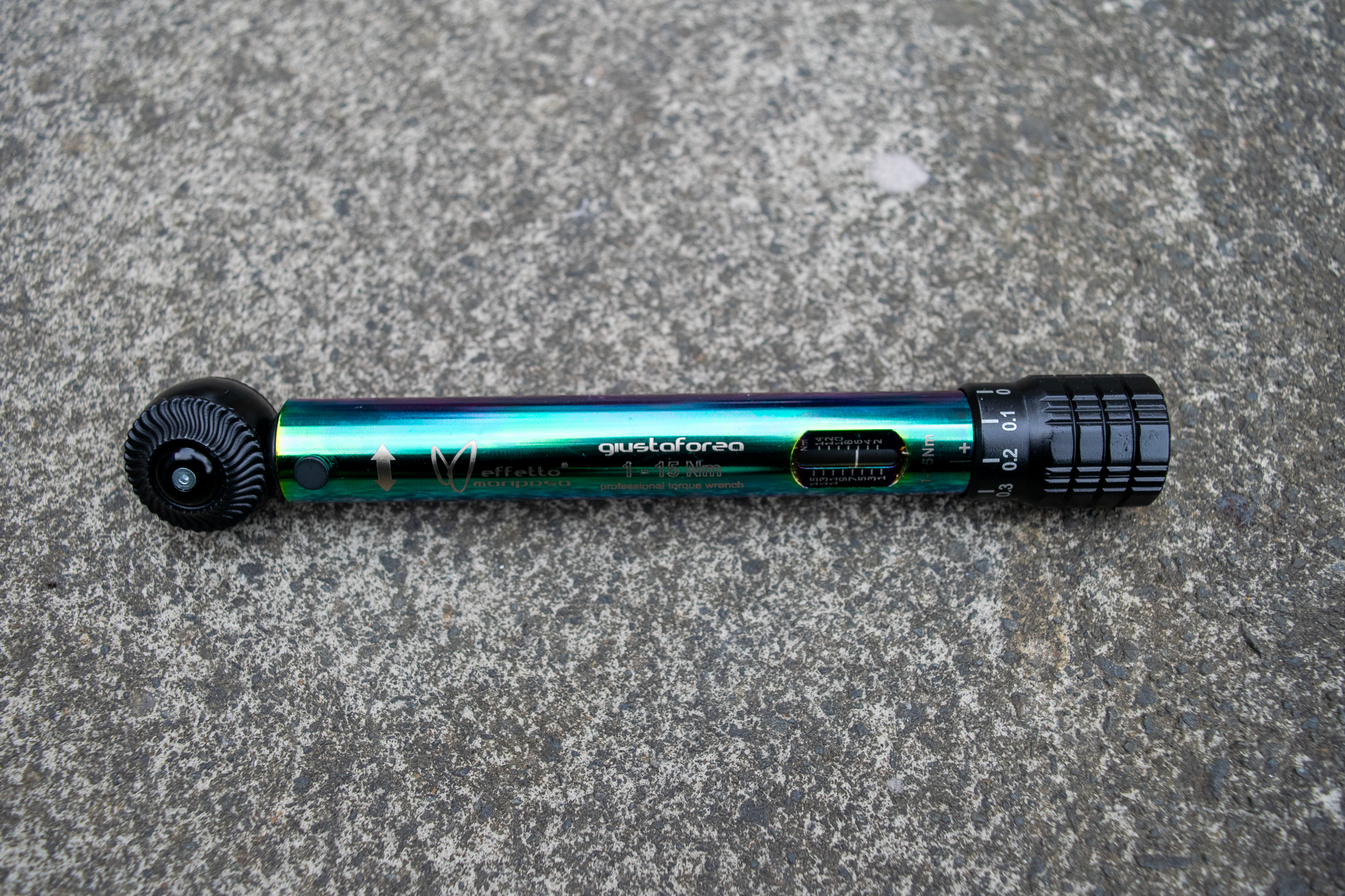
The stylish Giustaforza 1-15 Pro Evo is the top-line torque wrench from Effetto Mariposa. It covers a 1-15Nm torque range. The Evo is the model for you if you want to treat yourself or someone else; it comes in a nice tool roll with bits included.
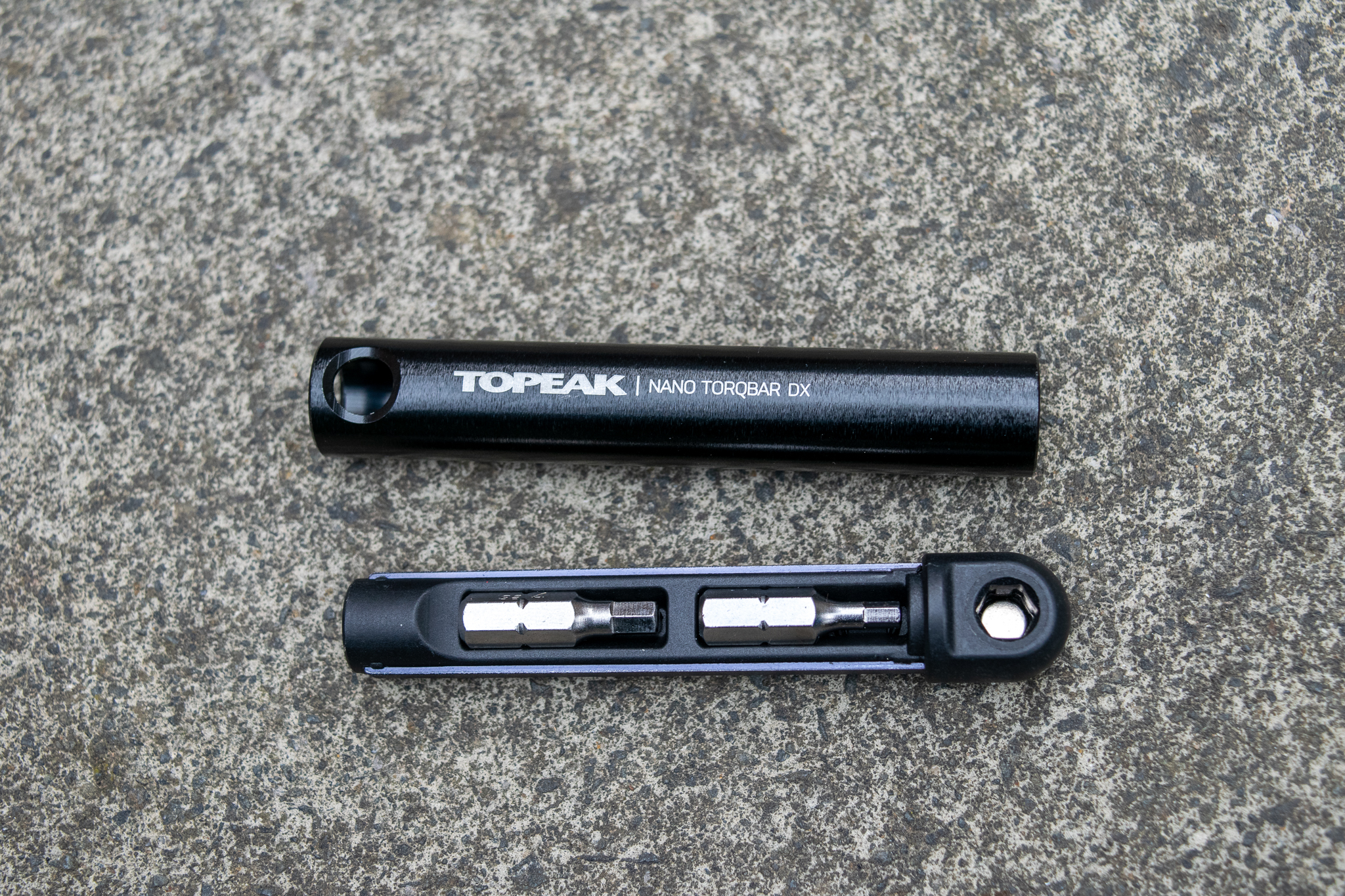
The Nano Torqbar DX consists of three pre-set torque adaptors and five bits that can be loaded into the tool body and handle. This means you can travel with it or carry it on rides very easily.
Read more below
Last updated on 21st of October 2025 We added a new entry for the best heavy-use wrench in the form of the Park Tool TW-6.2 unit. We also added a useful explainer on what you should look for when shopping for the best bike torque wrench.
Best bike torque wrenches you can buy today
You can trust Cyclingnews
Best bike torque wrench
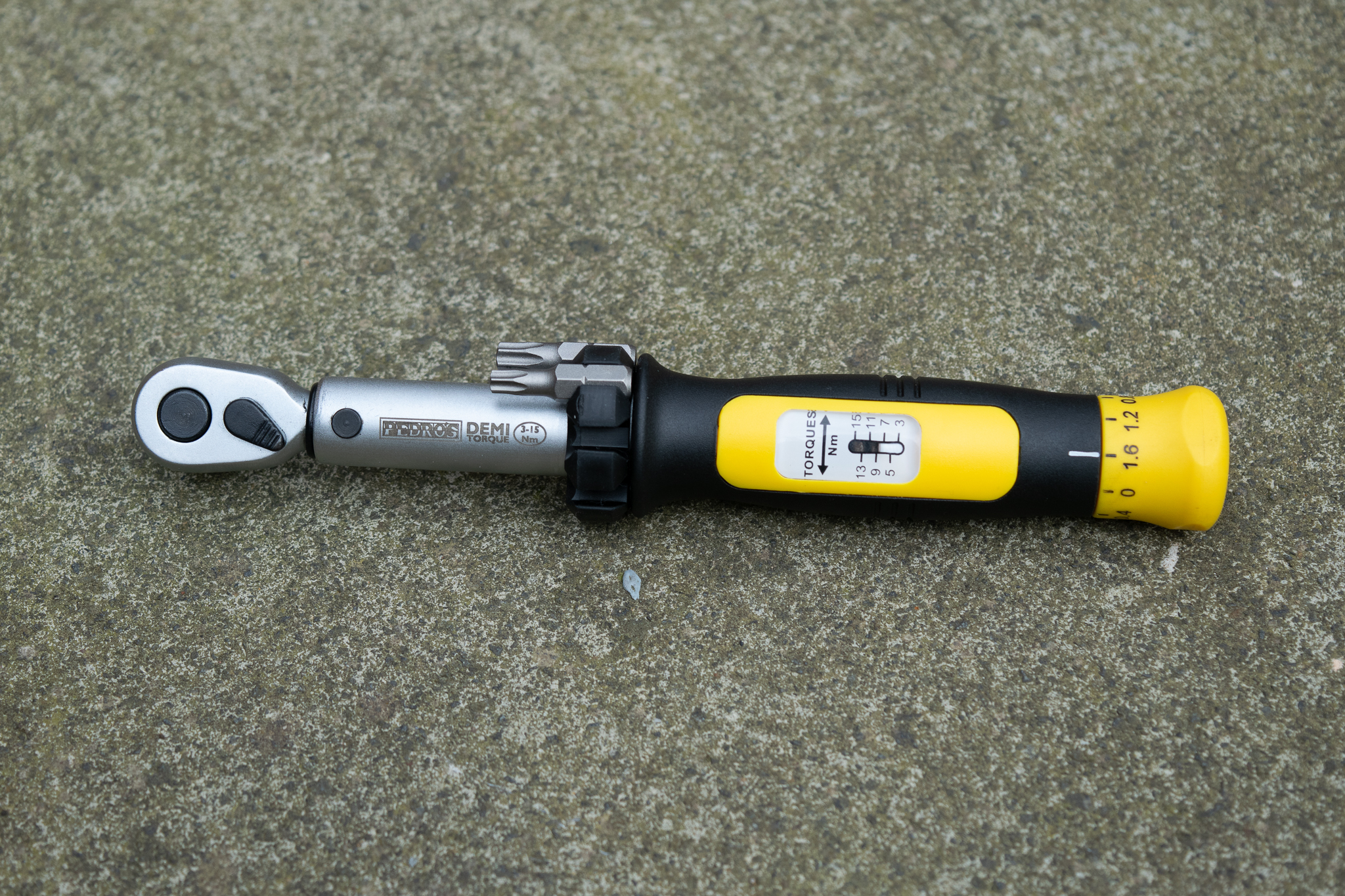
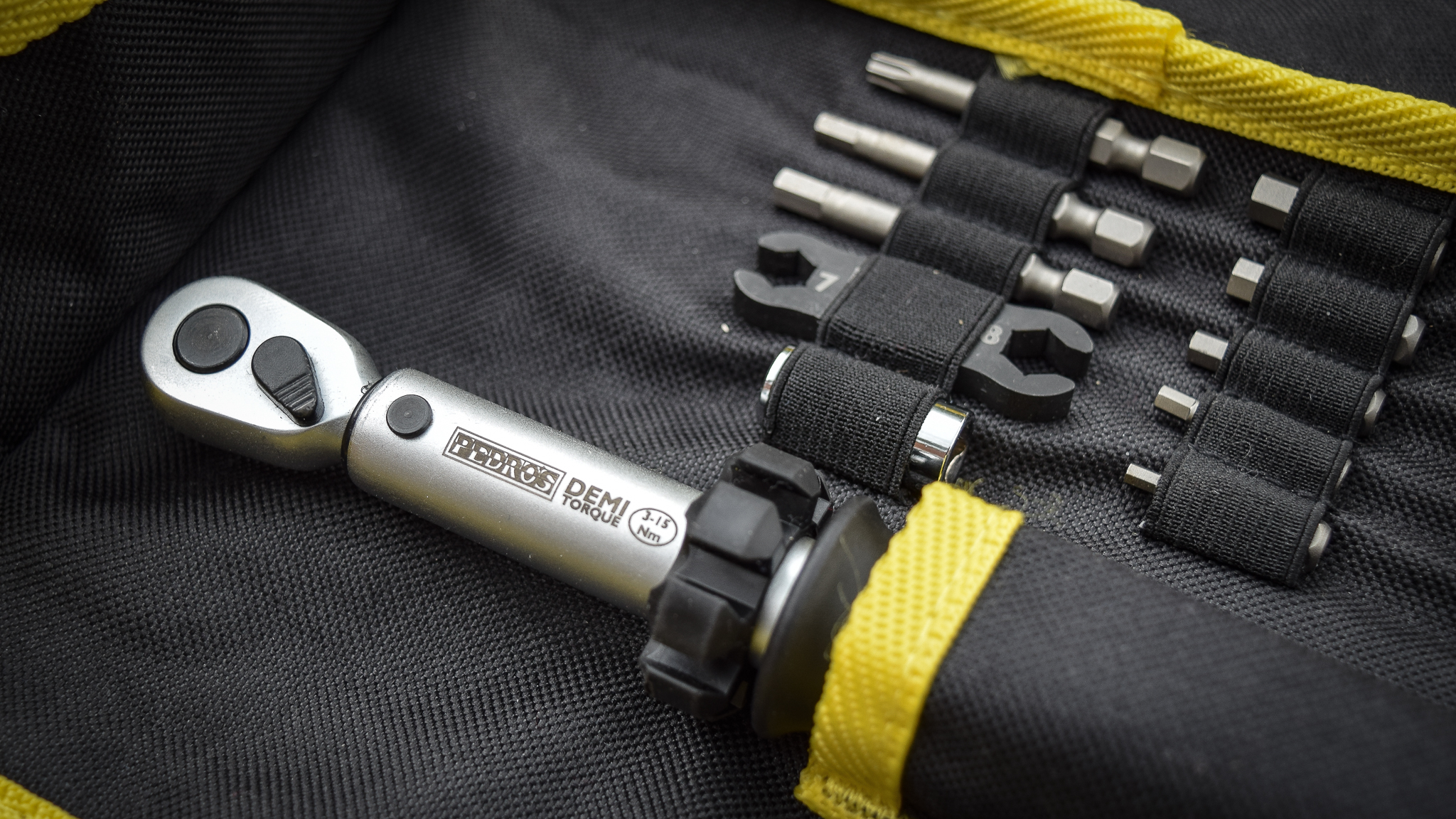
1. Pedros Demi torque wrench II
Specifications
Reasons to buy
Reasons to avoid
✅ You want bits included: The wrench comes with 15 included bits, which should cover every bolt on your bike.
✅You are regularly installing brake hoses: Crow's foot adapter is perfect for torquing hydraulic brake hose nuts.
❌ You want to torque past 15Nm: Most bike components dont need high torque rates, but if you do its worth noting this torque wrech only goes to 15Nm.
When it comes to choosing the best bike torque wrenches, Pedros Demi Torque wrench is our pick and it brings a lot to the table if you're shopping for a torque wrench.
The wrench itself is a compact and lightweight unit that covers a torque range of 3-15Nm. This is similar to several wrenches in the guide and will have you covered for a lot of common maintenance tasks on the bike. You'll be able to torque all of your handler and stem bolts, most component bolts like derailleurs and brakes, not to mention a range of accessories and computer mounts.
The wrench comes with 15 included bits, including 2.5, 3, 4, 5, 6 (25mm), 4 & 5mm (50mm) hex bits and T10, T15, T20, T25, & T30 (25mm), T25 (50mm) Torx bits.
A standout feature of the Demi Torque wrench for me is the included crow's foot 7/8mm adaptor, essential if you're torquing off hydraulic brake hose nuts on shifters or brake levers, a common job on road bikes due to internal cables, particularly for shop mechanics these days.
This torque wrench will comfortably have you covered for torquing things like handlebar controls and saddle and seatpost bolts, but the included bits mean you can do a lot more with it too, if you need to.
Best budget option
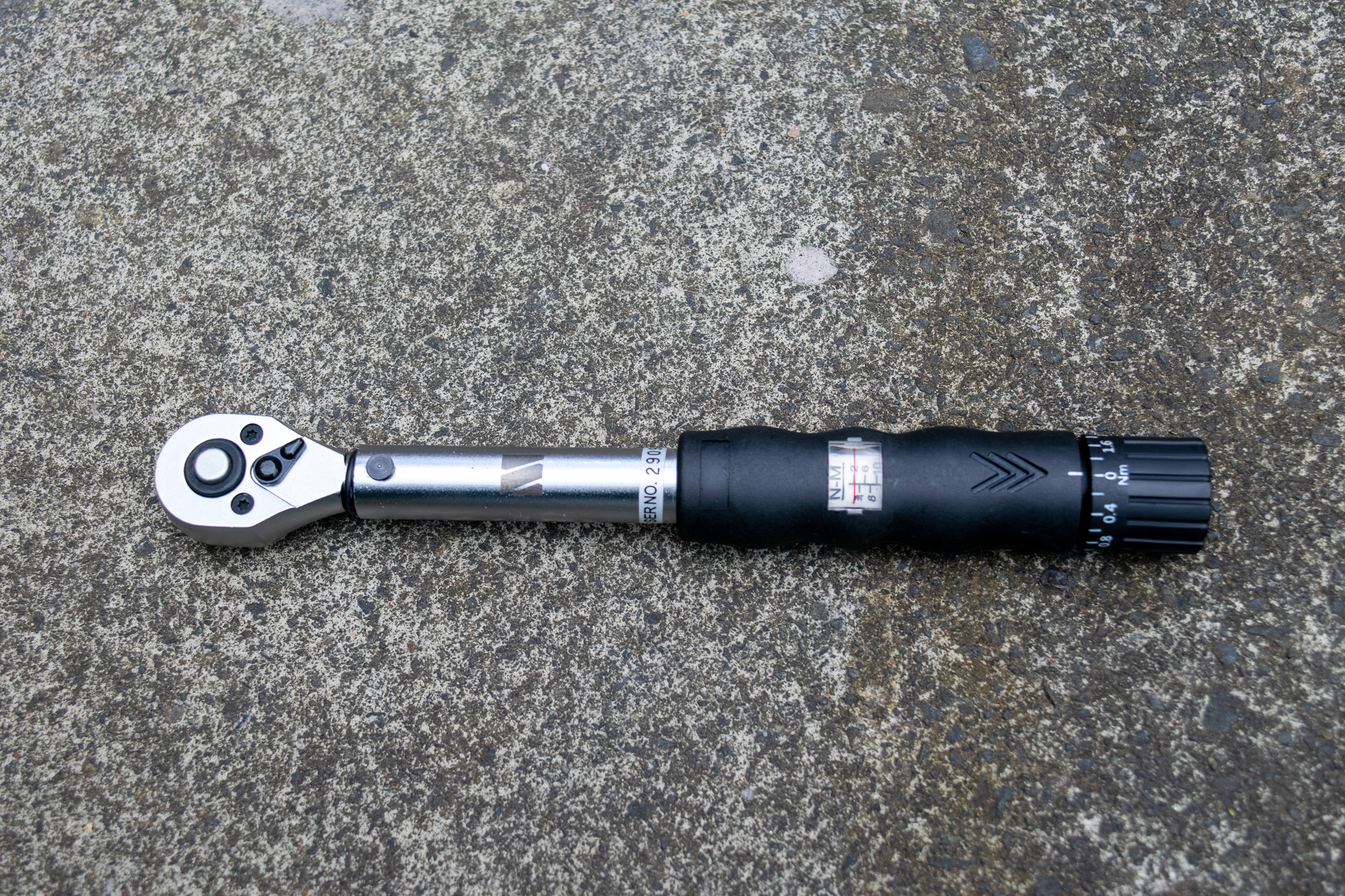
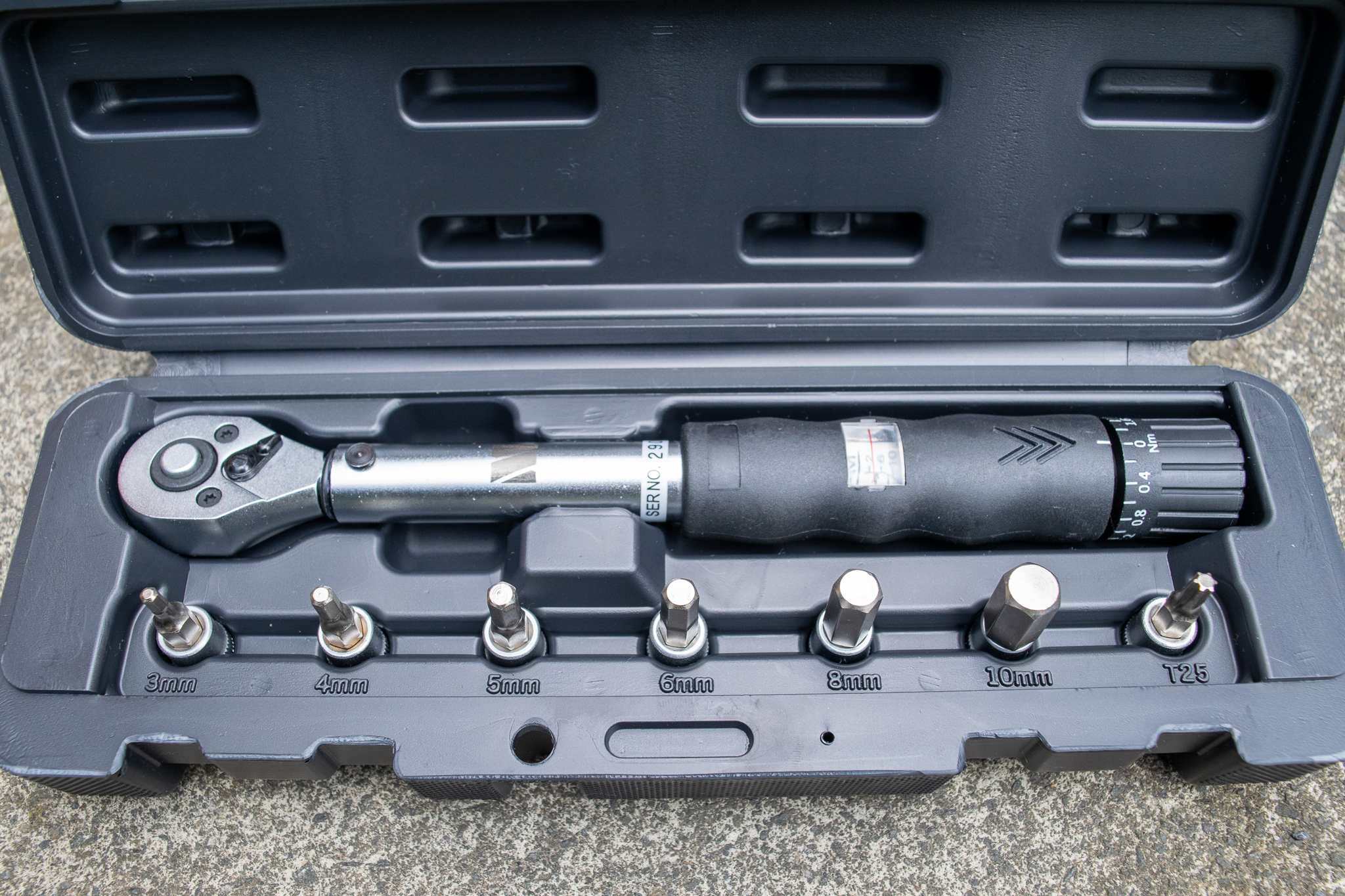
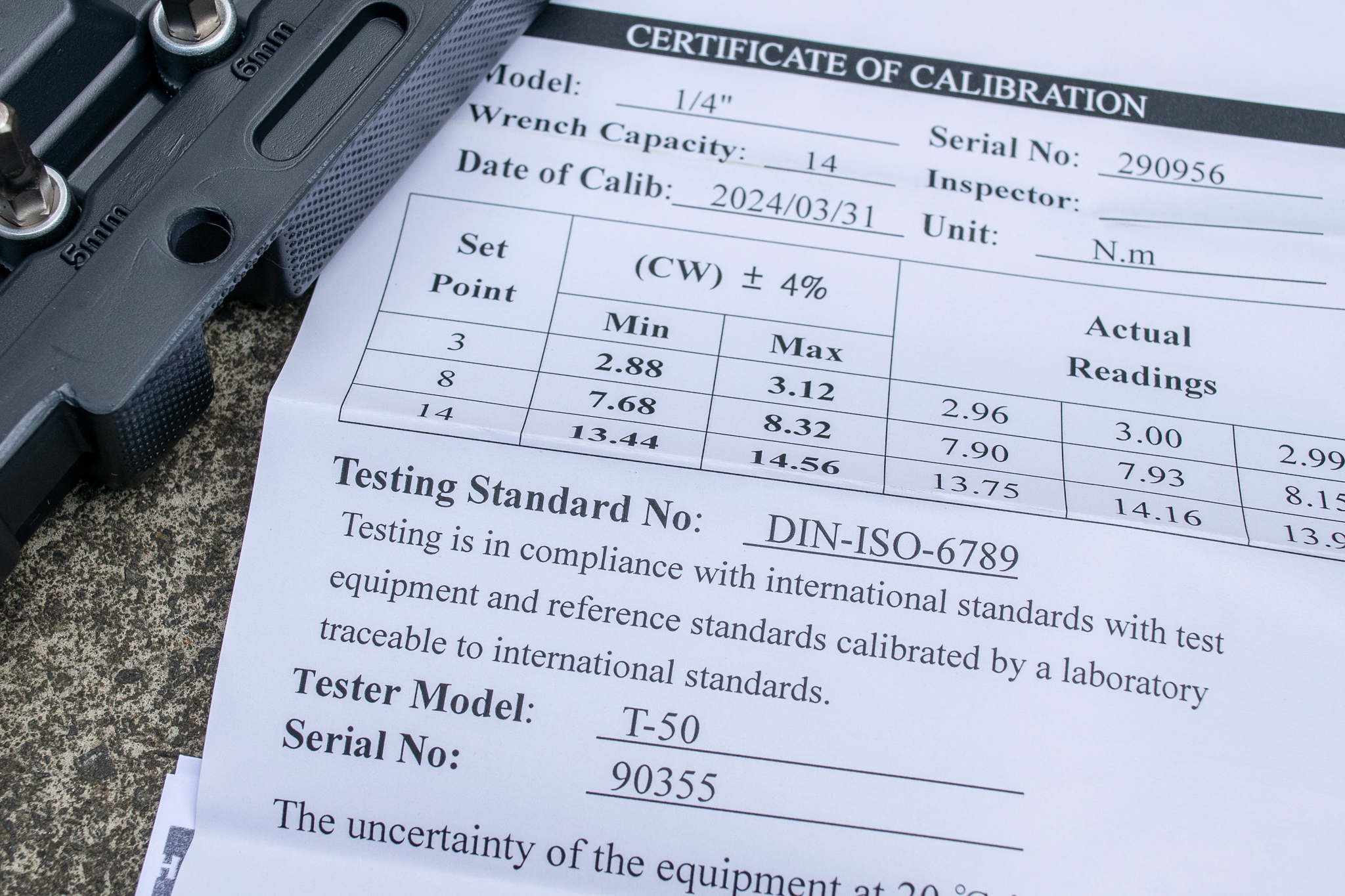
Specifications
Reasons to buy
Reasons to avoid
✅ You want a good quality, affordable torque wrench: You don't need to spend a lot of money on a torque wrench to work on your bike.
✅You need some hex and torx bits as well: Included hex and torx bits cater for the majority of bikes.
❌ You need to work past the 15Nm rating: If you need to torque beyond 15Nm you will need to choose a different torque wrench.
The M Part torque wrench is our best budget offering and is a great buy for the money.
The wrench itself comes in a hard plastic case and includes six hex bits. These are 3,4,5,6,8,10mm hex bits and there's also one T25 torx bit. This is a nice spread of sizes and, like the Pedro's unit above, will mean you can do a lot on the bike.
The unit comes with a calibration certificate in the box, and it's calibrated to the ISO 6789 standard, the same as several other wrenches in the guide. It has a loud and satisfying 'click off' when you reach the desired torque, and the micro-scale on the adjuster dial means you can work accurately.
If you want to invest in a torque wrench to use on your bikes but don't want to spend too much, I recommend going for the M Part, it brings a lot to the table for the price.
Read our in-depth M Part torque wrench review.
Best for heavy use

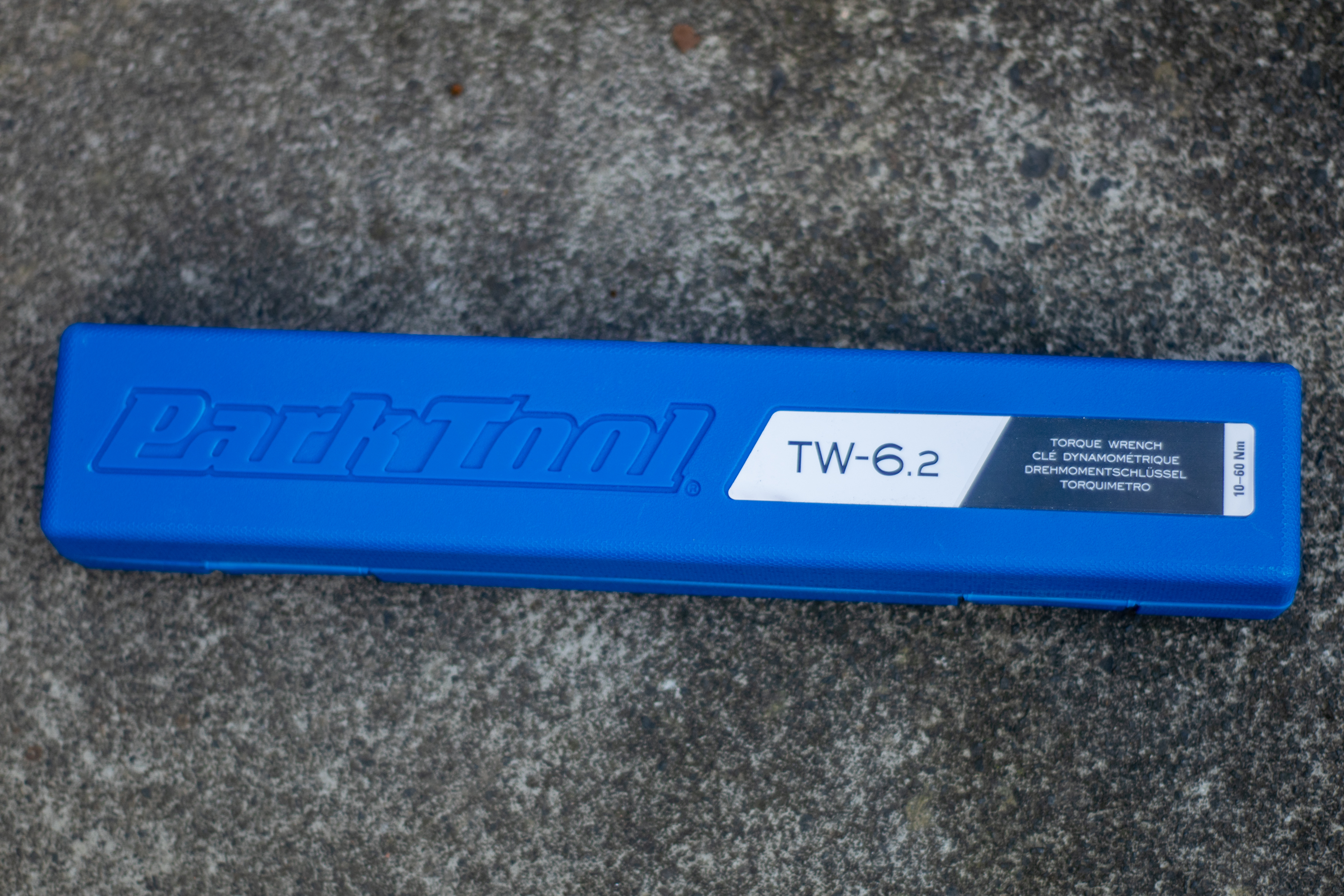
3. Park Tool TW-6.2
Specifications
Reasons to buy
Reasons to avoid
✅ You need to work up to 60Nm: The high torque range is perfect for torquing things like cassette lockrings, crankset bolts and disc rotor lockrings.
❌ You need to torque bolts below 10Nm: Most handlebar stem bolts and seatpost clamps are only torqued to 4 to 6Nm, meaning you can't use the TW-6.2 for these jobs.
The Park Tool TW-6.2 torque wrench is the best option if you want a larger wrench that gives you the ability to work to a higher torque rating. This will be a great option for tightening things like cassettes, chainset bolts and disc rotor lockrings.
The TW 6.2 features a 3/8" square drive head and covers a torque range of 10-60Nm, it’s heavier weight and 36cm length to make it better suited to working on things like crankset bolts and wheels. There’s also a handy Nm to In lb conversion sticker on the wrench that I haven’t seen on another bike-specific unit.
The wrench comes in a sturdy blue case, which is always nice, and the torque is adjusted at the bottom of the wrench using a dial which you push in and rotate clockwise. The dial itself is marked with 0.5Nm increments for increased accuracy, and there’s a clear plastic window further up the body with a scale that increases in 5Nm increments.
There’s a 1-year warranty, and Park Tool offers a calibration service if and when you want to get your unit calibrated.
Best digital option
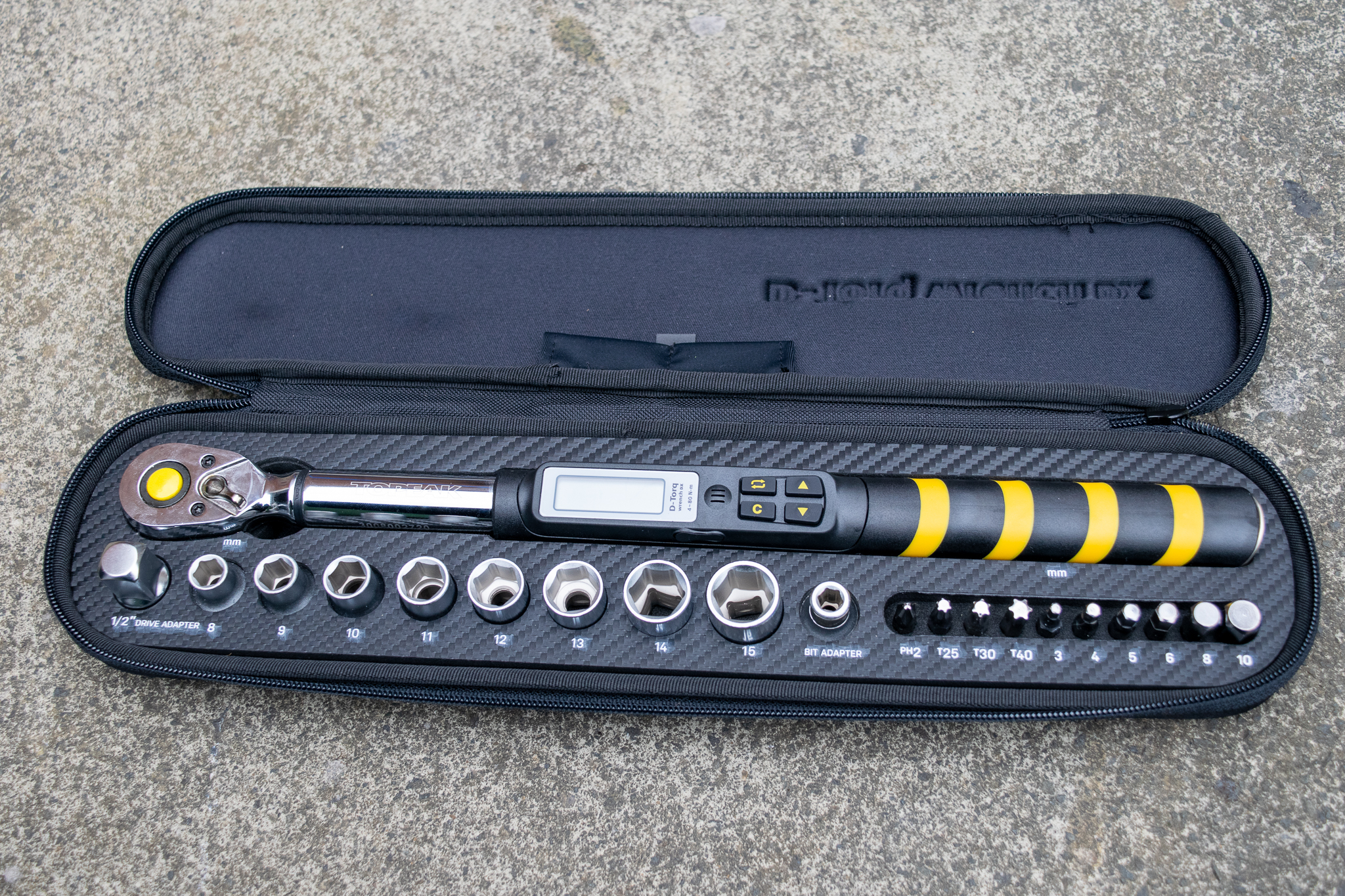
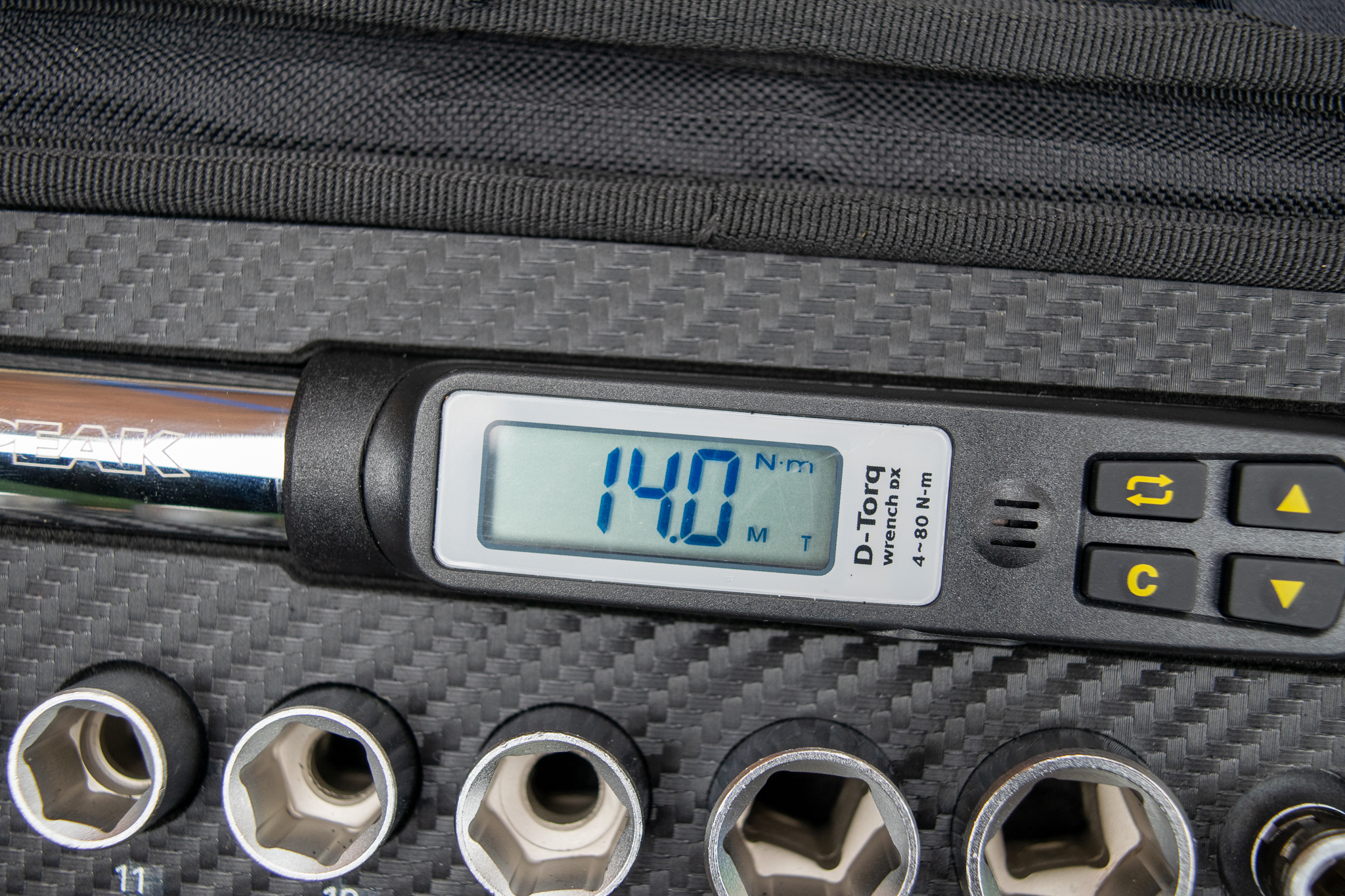
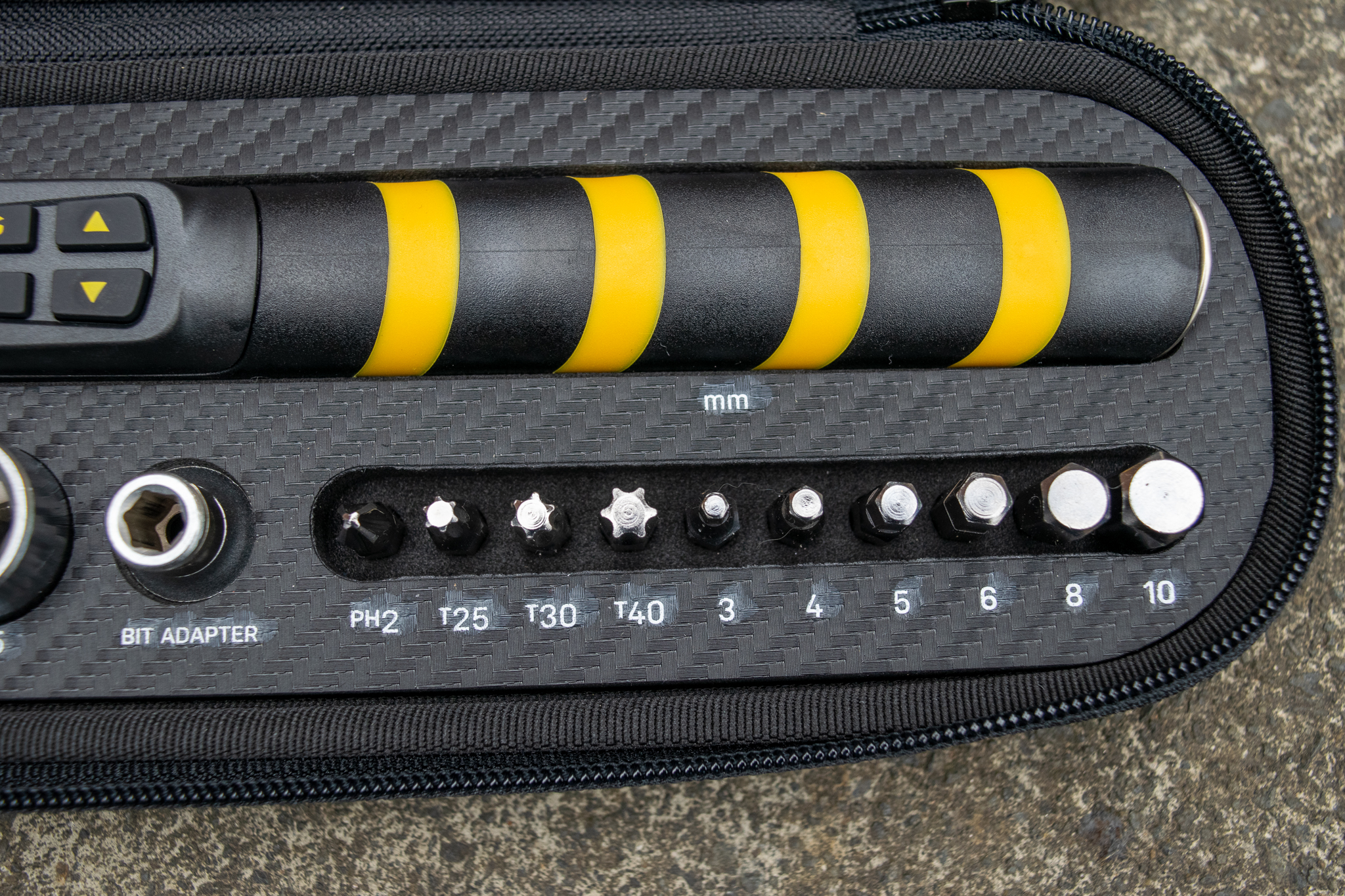
4. Topeak D-Torq DX
Specifications
Reasons to buy
Reasons to avoid
✅ You want to save time over manually adjusting a non-electric unit: Electric read-out gives fast and accurate torque output.
✅ You want some tools included with your torque wrench: Topeak includes a good range of bits and sockets with the D-Torq DX.
❌ You are on a budget: This is a pricier option compared to manual torque wrenches.
The Topeak D-Torq DX is an electronic, 3/8" drive torque wrench that covers a huge torque range of 4-80 Nm, meaning this torque wrench has the ability to cover everything on a bike.
If you like the idea of an electronic torque wrench and also like the idea of using one wrench for everything, the D-Torque DX will allow you to hit the ground running.
It comes in a smart carry case with one of the largest ranges of included bits and sockets, including a 1/2" inch drive converter socket, something I mentioned needing when using the BBB option. I also really like the carbon effect surrounding in the case, it just looks techy and cool.
Another point that highlights itself to me whenever I use the wrench is the ease with which you can set your desired torque with the soft rubber buttons compared to manually adjusting a mechanical wrench. If you suffer from any arthritis or similar issues and want to keep repetitive movements to a minimum, this makes things really useful and saves some effort. I know I tried to minimise repetitive movements when spannering all day every day. The wrench then beeps not clicks, when you reach your desired torque rating.
Though the wrench covers a huge range of torque, it is a little longer than some of the more compact wrenches in the guide and may make working in tighter spots a little awkward, just something to think about, although you could always invest in a smaller or pre-set unit at a later date.
Best premium option

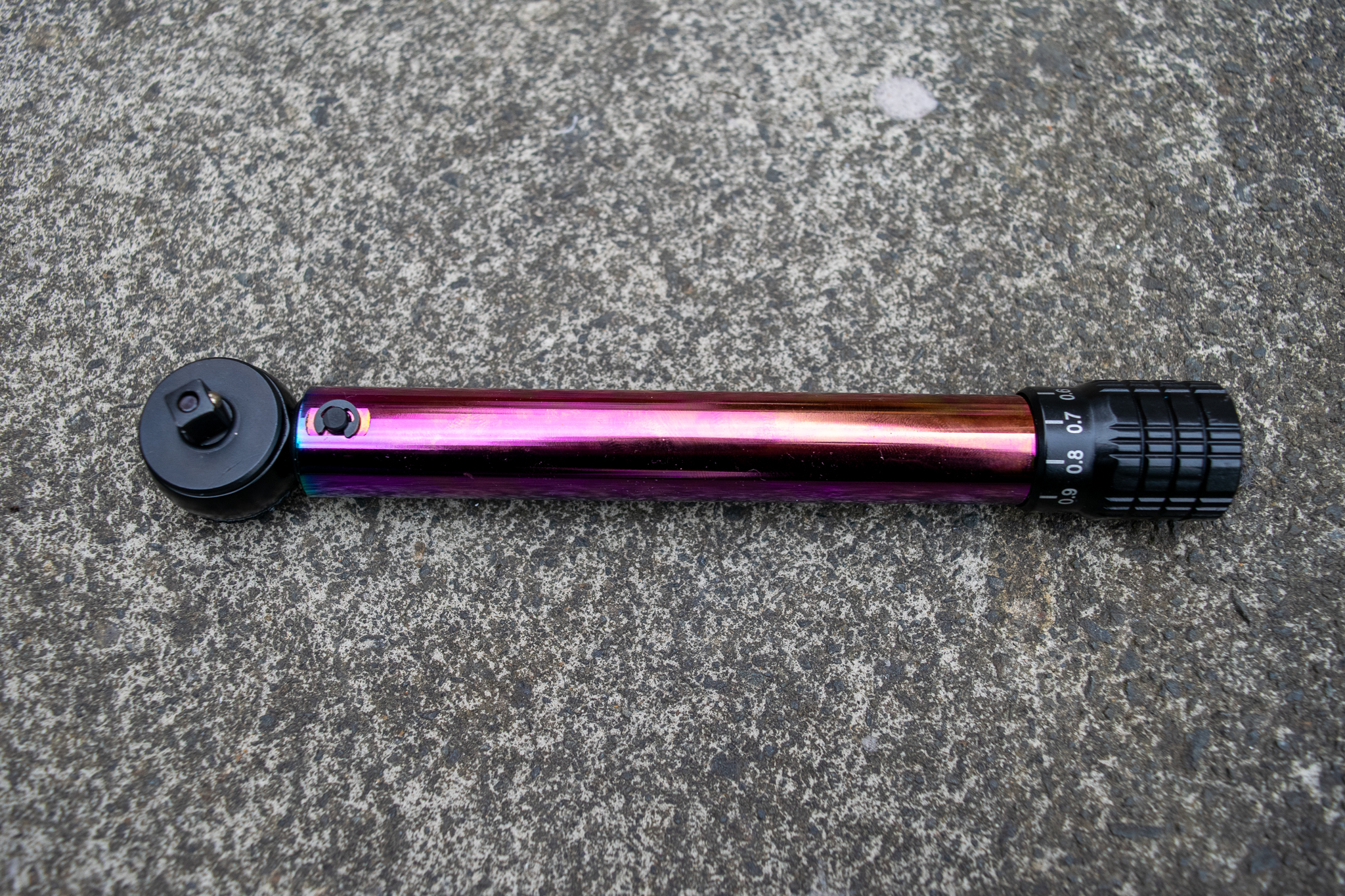
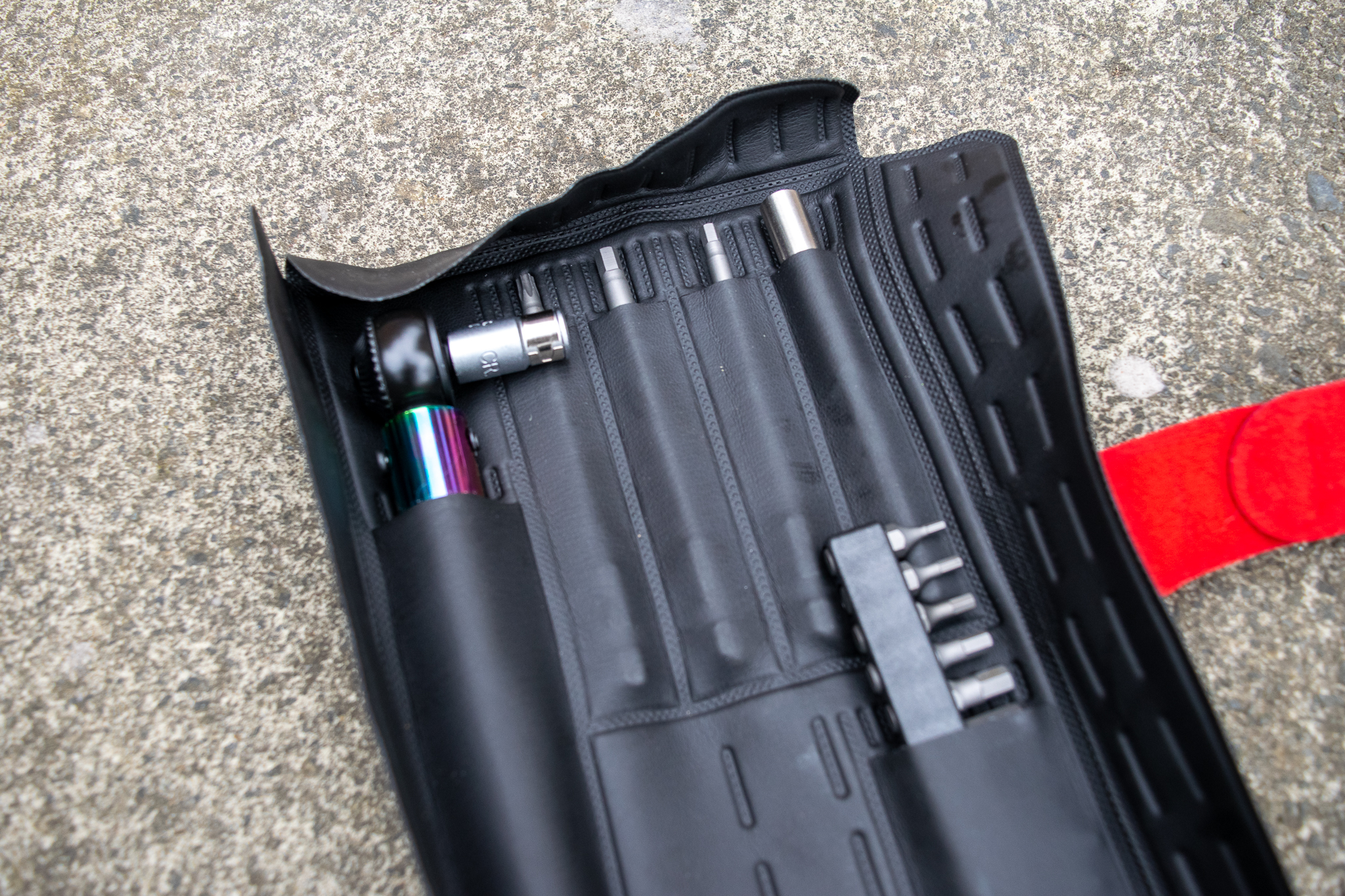
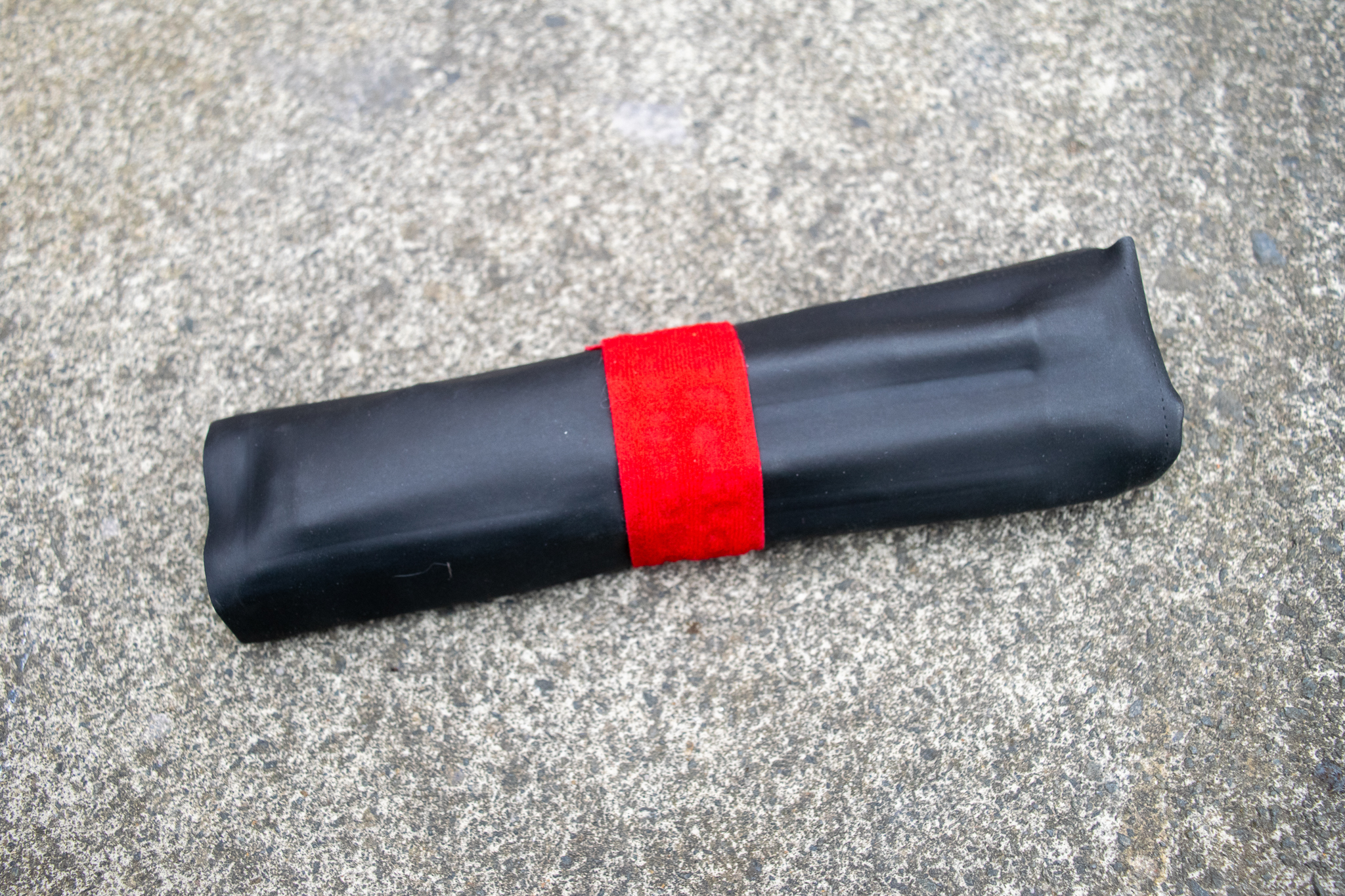
Specifications
Reasons to buy
Reasons to avoid
✅You want to treat yourself: Premium finish makes it a pleasure to work with.
✅ You would like a case and bits as well: Bits are included and everything is packaged neatly in the included roll.
❌ You're on a budget: This is a pricey unit, and you can do the same for less cash.
If you want to treat yourself or are perhaps buying the cyclist in your life a special present, you might want to look at the Effetto Mariposa Giustaforza 1-15 Pro Evo.
Effetto Mariposa overhauled its torque wrench lineup this year, and the 1-15 Pro Evo supersedes the Giustaforza 2-16 Pro model that was previously featured in our guide.
The new 1-15 Pro Evo gets an oil-slick finish, which is rather flashy, though admittedly it doesn't bring any extra functionality to the table. It does make for a more special feeling though. The Pro Evo gets a 1-15Nm torque range, which has changed slightly from the old units 2-16 and also features a clockwise and counter-clockwise tightening calibration, useful for suspension hardware and the like.
Also new is the new micro-scale on the torque adjusting dial, which also locks into place. I've found this very useful on parts that have a specific torque reading, like 6.2Nm for example.
The wrench is available on its own or with a nice tool roll and bits, as pictured, for some extra cash. There is also a standard 'Pro' model available for less cash, which is all red, and just loses out on the dual-direction torque tightening feature the Evo gets. There are less expensive wrenches in this guide which offer similar performance points, but if you're looking for a special feeling tool to use at home or work, the Guistaforza remains a nice, high-end option.
Read our in-depth Giustaforza 1-15 Pro Evo review here
Best for workshops
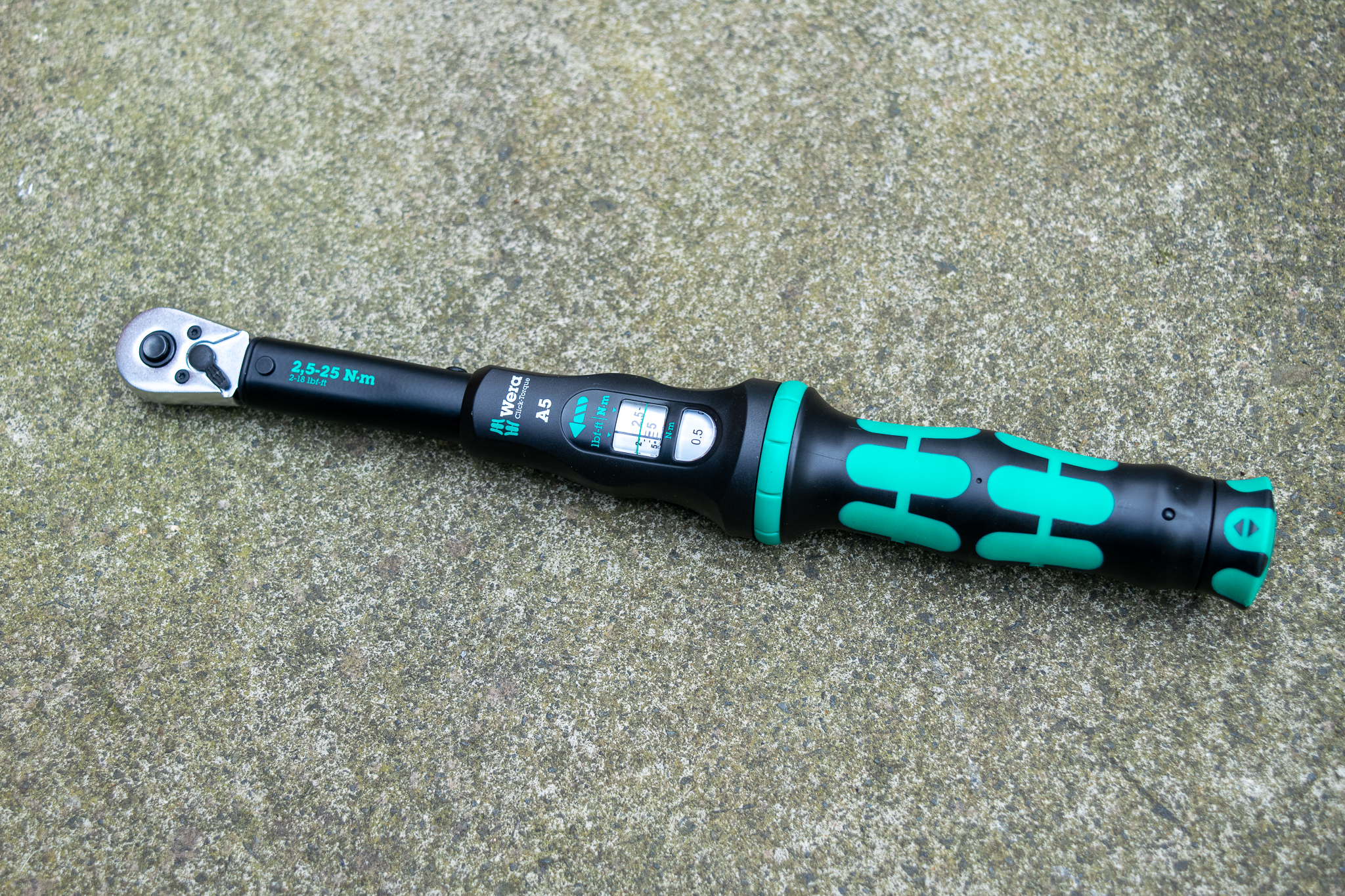
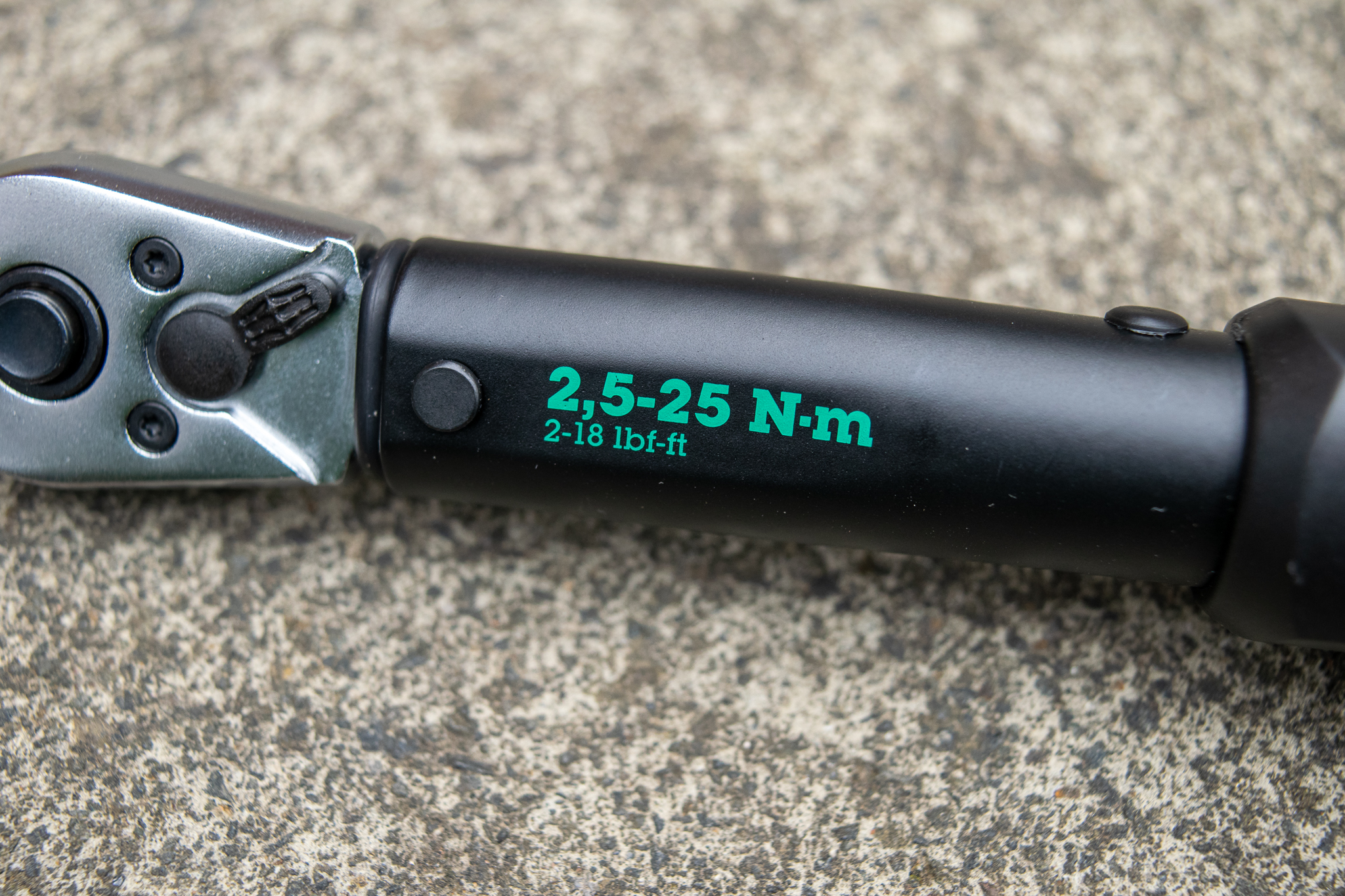
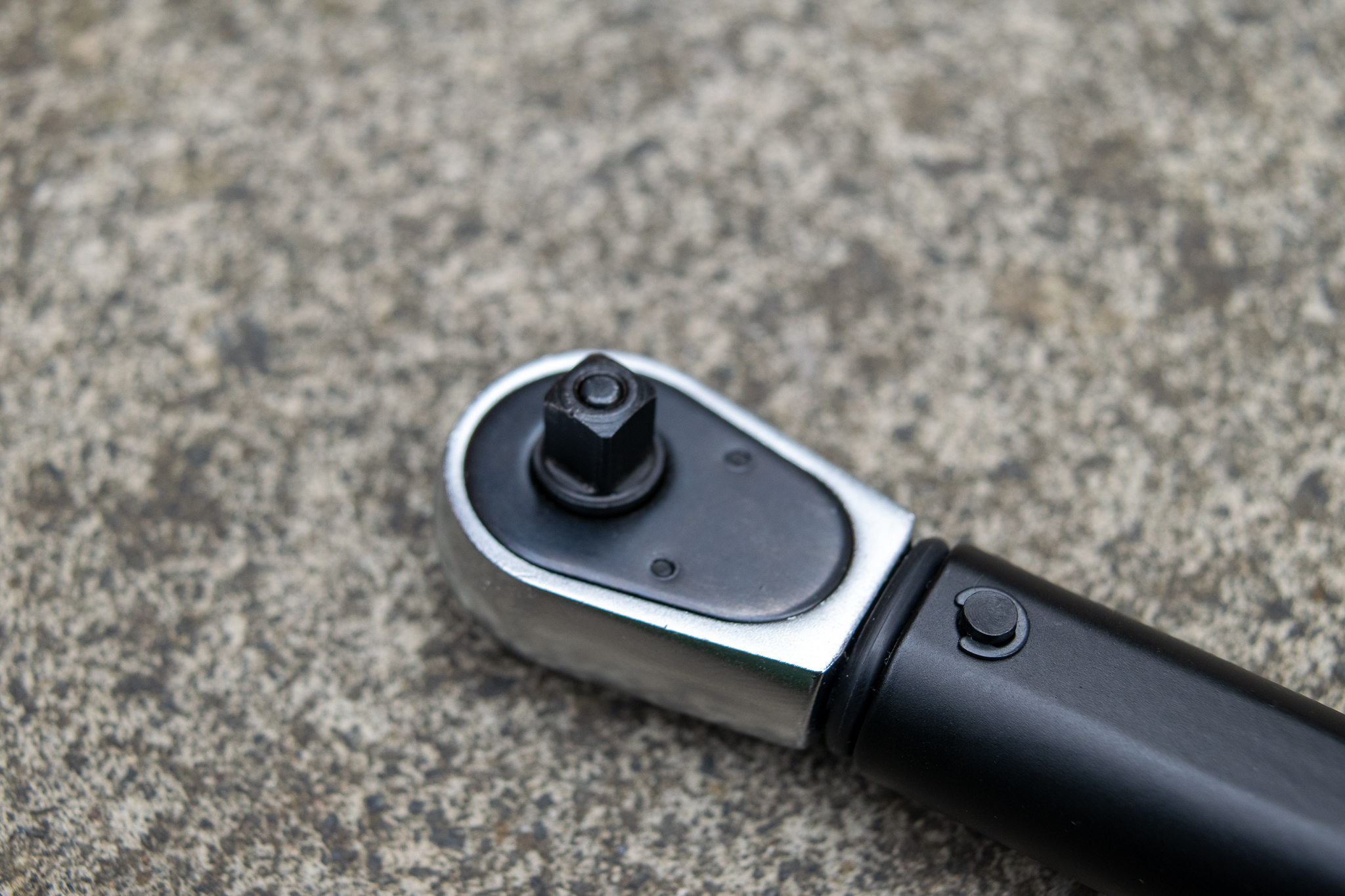
6. Wera Click Torque A5
Specifications
Reasons to buy
Reasons to avoid
✅ You want a quality, well-constructed torque wrench: Comfortable handle and durable finish make this a great option for working with all day.
✅ You want an accurate torque wrench: The Click Torque A5 is calibrated to the newest, most stringent ISO standard.
❌ You need to work past 25Nm: Enough range for all but the highest torque needs.
❌ None of your sockets are for 1/4" drive: The 1/4" drive and the fact it doesn't include bits means you may need to invest in extra bits or adapters.
The Wera Click Torque A5 is a 1/4" drive click-style torque wrench with an operating range of 2.5-25nm. This means it's suitable for everything on the bike, except cassette and disc lockrings and larger crankset bolts. It's 30 cm long, making it mid-sized against the wrenches in this guide. It's definitely a tool for home use rather than travelling or riding with.
It's a larger unit and will be highly accurate and reliable, making it ideal for shop environments. The A5 conforms with the ISO678-1:2017 calibration standard and comes with a certificate of conformance. I learnt during my metrology lab visit that the 2017 standard is very stringent and checks the torque wrench across a great many test points.
It uses a 1/4" square drive fitting and doesn't come with bits. So you may need to invest in some 1/4" drive bits and adaptors as needed.
I liked the ergonomic, comfy handle, and if you were using this wrench several times a day, I think it would start to come into its own. The click when torque is reached is also loud and easily audible. Once the bottom adjuster dial is pulled open, the whole lower body of the torque wrench rotates with a really nice light action, allowing you to set the desired torque spec quickly and easily.
This isn't specifically a shop-level tool but it would make a great addition to any workshop or garage setup. Wera also offers a calibration service in the UK that you can send the wrench back to if needed.
Small and lightweight
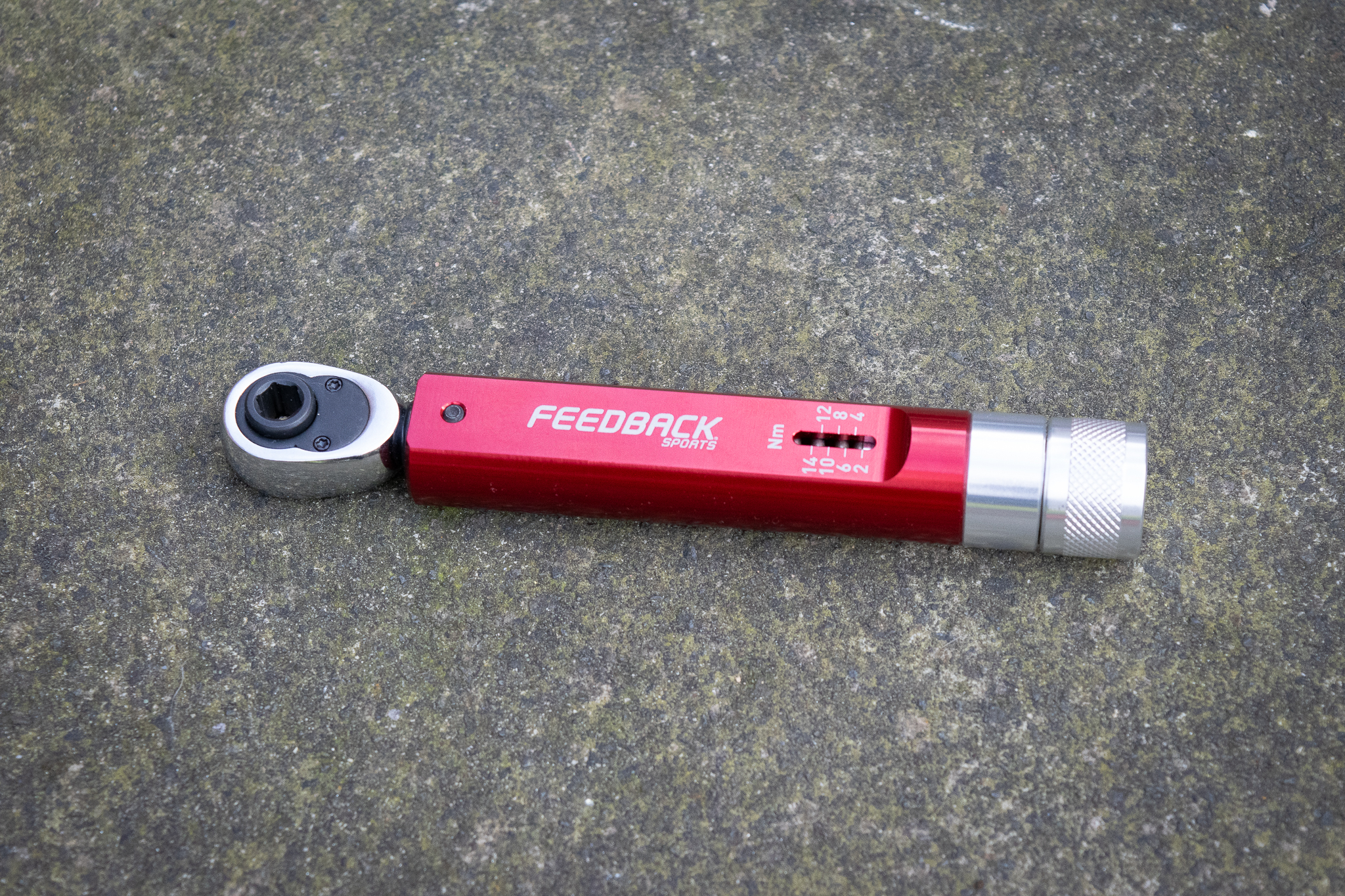
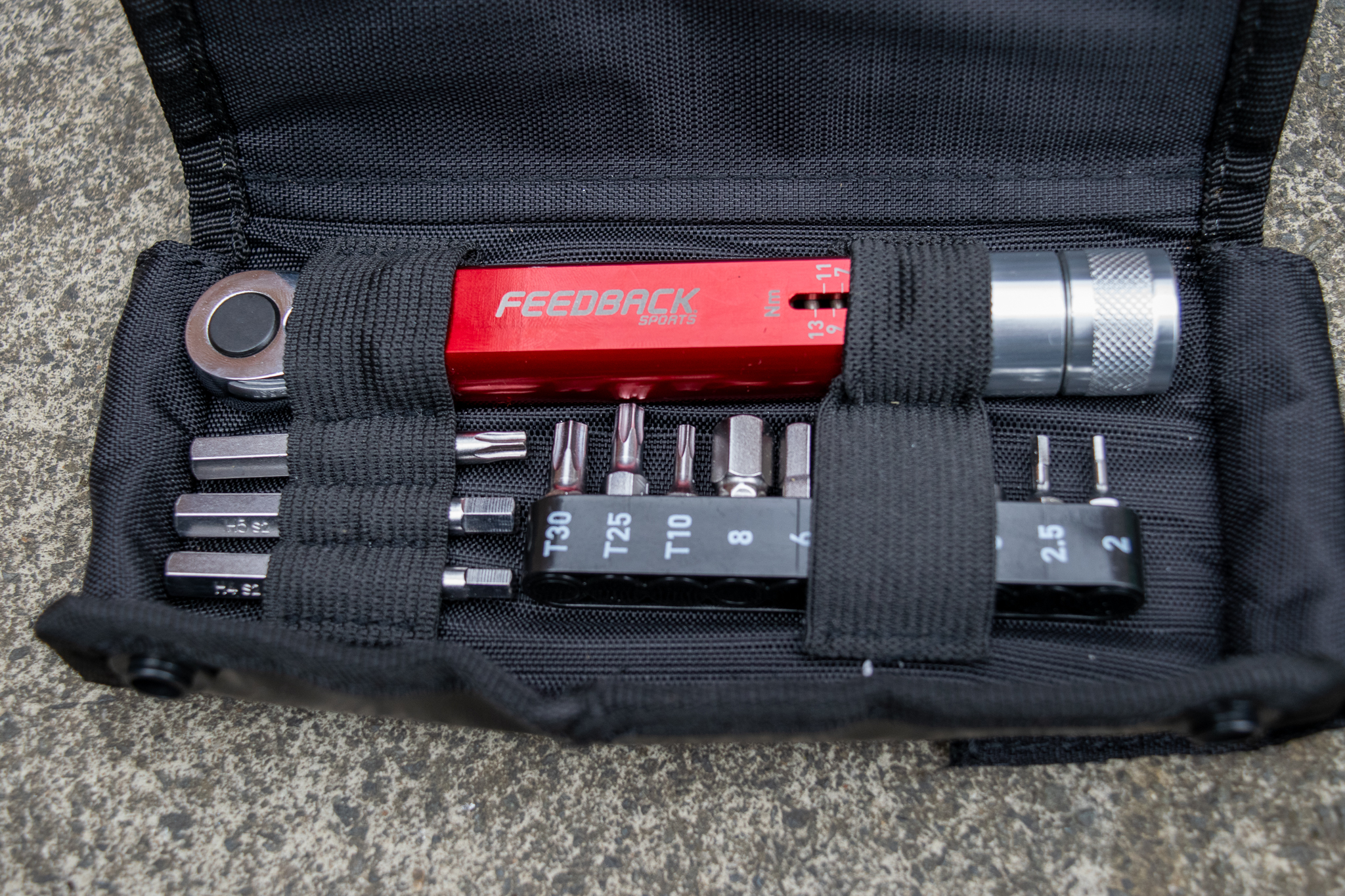
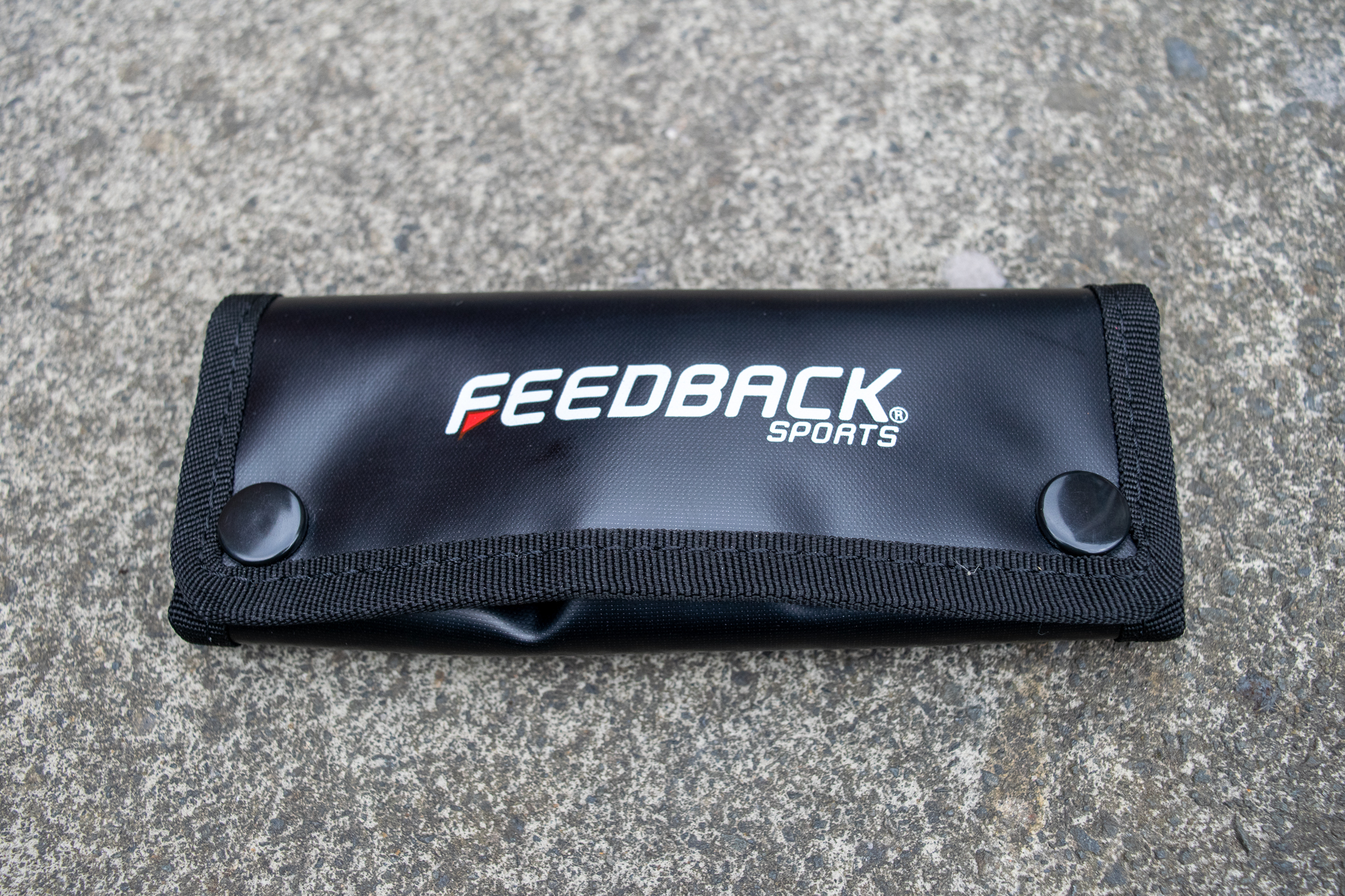
7. Feedback Range Click Torque Wrench
Specifications
Reasons to buy
Reasons to avoid
✅ You want a small, portable torque wrench with a case and bits: Perfect for stashing in a travel bag or your car for torquing away from the workshop.
❌ You need to torque past 14Nm or half increments: The 2-14 Nm range is only adjustable in 1Nm increments.
The Range Click Torque Wrench from Feedback Sports is an updated offering from the American brand. I really like this neat, compact torque wrench and it comes in a smart travel case with 13 of the usual hex and torx bits.
The Range Click has a 2-14 Nm range, which increases in 1Nm increments. Feedback is fairly specific about how you hold the wrench to torque things off, so it's worth reading the brand's guidelines for best practice. When torquing something off, you will need to hold the silver end section of the wrench, so use your other hand to hold the head and stabilise the tool. It's easy to do in use.
The wrench promises + / - 4% accuracy over 4000 cycles and Feedback offers a calibration service of its own. This is a pleasant torque wrench to use and if you like the size and look of the Effetto Mariposa option above, this will provide a similar experience for a lot less cash.
The case is a little on the large side to carry on rides, and it's probably overkill. But the size of the unit overall makes it ideal for taking to events of all kinds, it's compact and neat and won't take up a lot of space. I like its in-hand feel and for the price, it's a really attractive option.
Best torque multi tool
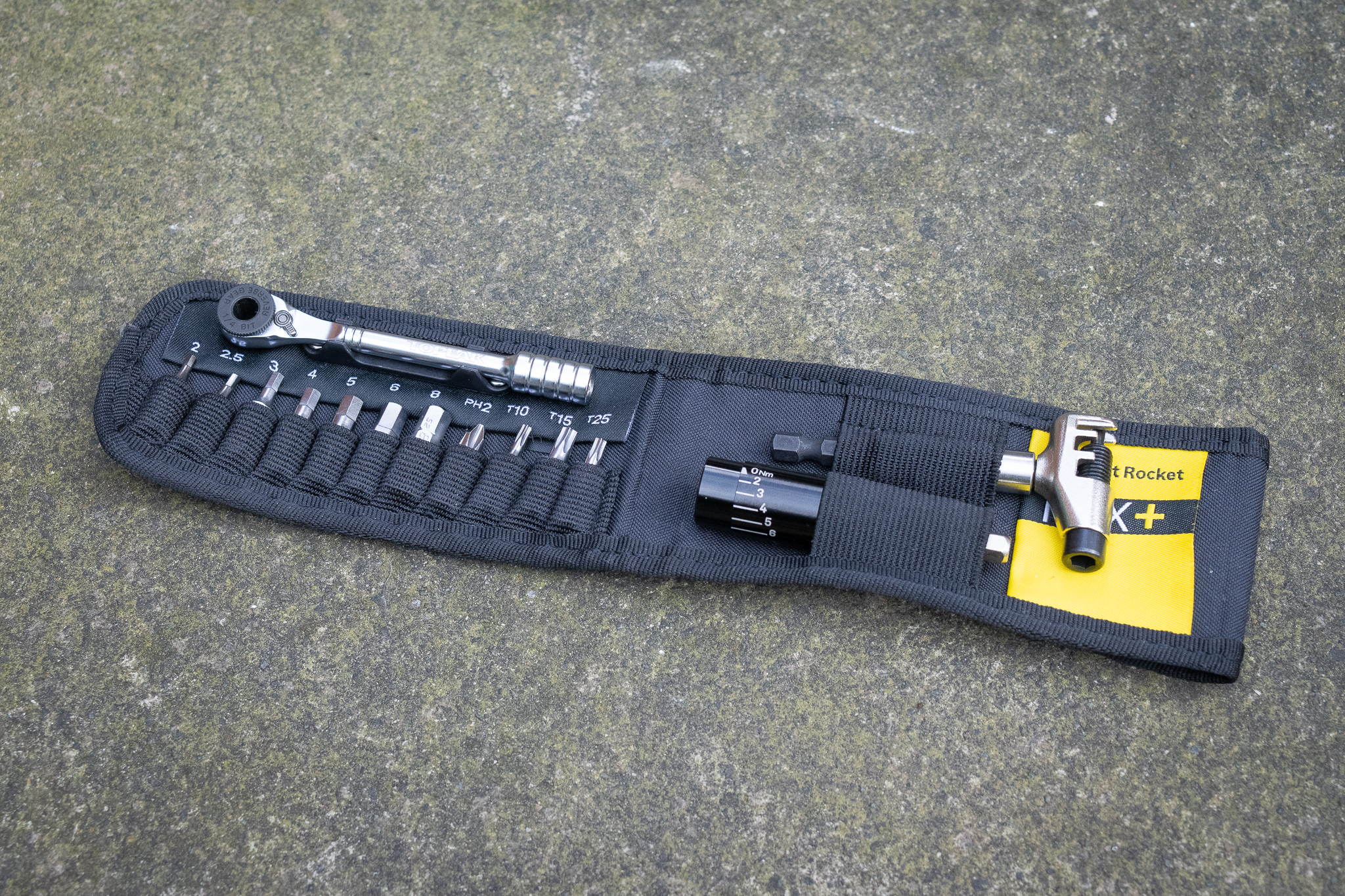
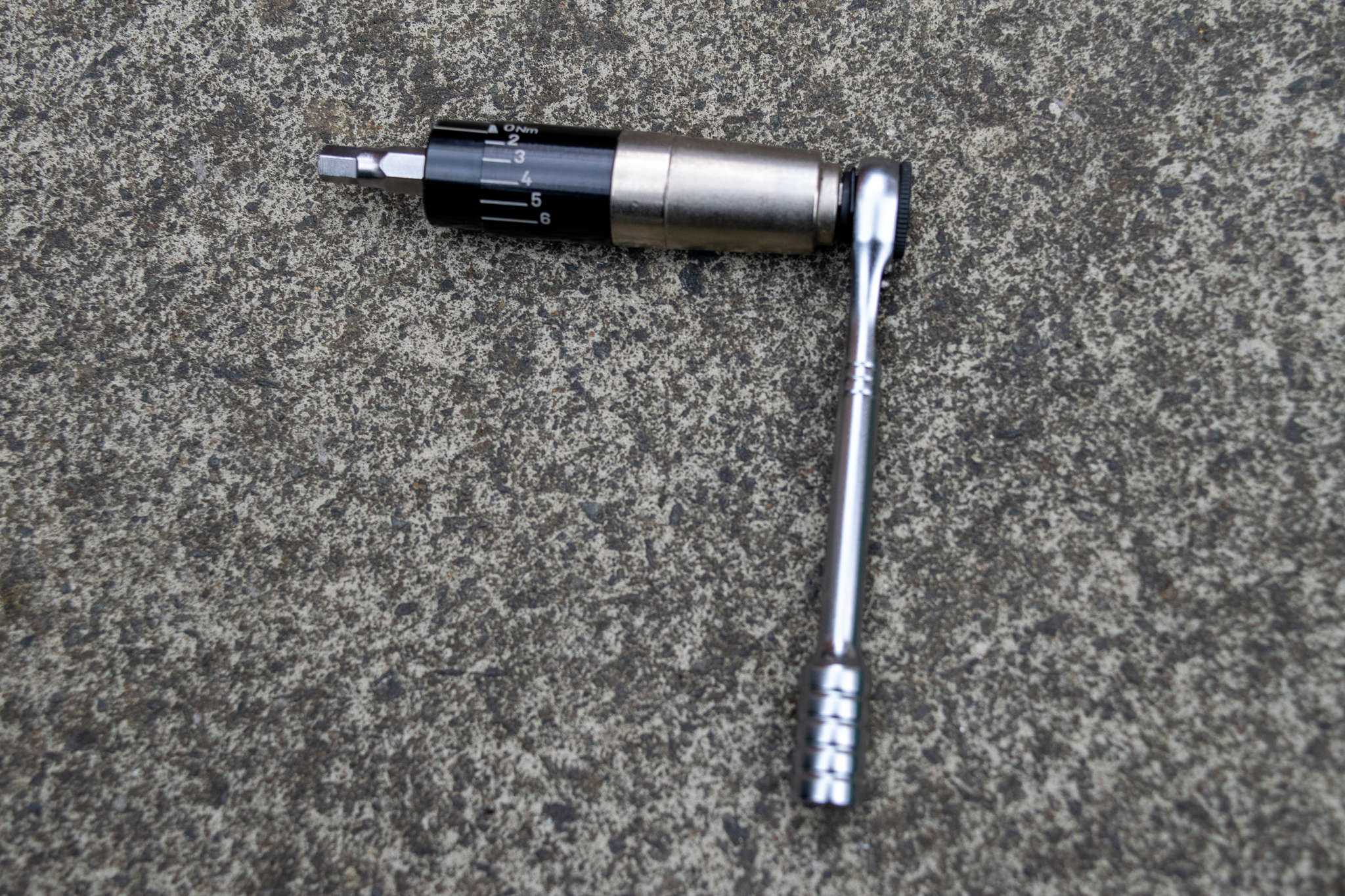

8. Topeak Ratchet Rocket Lite NTX +
Specifications
Reasons to buy
Reasons to avoid
✅ You want a multi-tool that can torque things too: The tool comes with loads of bits, a chain breaker and a ratchet tool making working on the bike much easier.
❌ You prefer your torque wrench to 'click off' when the desired torque is reached: We prefer having a tactile click when using a torque wrench.
The Topeak Ratchet Rocket Lite NTX + (phew!) is made up of a useful and well-thought-out range of tools kept in a neat velcro case. Included is a neat ratchet, chain splitter tool, 11 hardened steel hex and torx bits and a pre-set torque attachment that covers a 2-6Nm range. Ideal for working at home, or for travelling with, the case is also small enough that I can carry it in a cycling jersey pocket if required. It's the sort of tool that would be perfect to take on a trip if you need to work on your bike upon arrival.
You could pretty much build a bike with this kit, the 1/4" ratchet is extendable and has a reversible head and a nifty thumb wheel. I like that you can add a hex bit to the other end of the ratchet too, I recently found this useful when installing disc rotor bolts.
The torque attachment is useful and covers a 2-6Nm range, so this will be ideal for setting seatpost heights or adjusting handlebars. It doesn't click when torque is reached, you need to visually align the dashes on the unit, so this is worth bearing in mind. There is a 2-year warranty and pre-set torque accuracy is + / - 6%. This is an ideal tool to carry or have at home to make roadside adjustments and torque bolts, it won't be quite as accurate as a full-blown torque wrench, but if you need a smaller all-rounder, this is a great option.
Best to carry on rides




Specifications
Reasons to buy
Reasons to avoid
✅ You want a torque tool to travel with and carry easily on rides: Compact size means allows it to be easily stashed ina pocket or saddle bag.
❌ You can't see yourself needing to torque anything out on the road or at an event: The torque adapter doesn't offer any additional functionality beyond its limited torque abilities.
The Topeak Nano Torqbar DX is another great portable option and my go-to for carrying on the bike, especially for road rides, thanks to its small portable size and clever in-built tool storage.
It comes with three pre-set torque limiters of 4, 5 and 6 Nm and a selection of bits in a neat plastic case. You then add your desired limiter and hex bit to the tool body.
What I like is the fact that you can just carry the most relevant torque limiter for your bike and two hex bits inside the handle, making for a really compact setup for your saddle bag or jersey pocket if you want the ability to torque things like seatposts or bars out on the road.
The torque click is easy to miss though, so you will need to get a feel for this starting off to ensure you don't miss it.
Read our in-depth Topeak Nano Torqbar DX review.
How to choose the best bike torque wrenches
It's worth spending as much as you can afford on a quality torque wrench; you should end up with a quality, accurate tool.
Here's a quick list of the things that you should consider when shopping for the best bike torque wrench to work on your bikes with.
- Consider the torque range you need to cover: Not all torque wrenches will measure the same range. If you need low torque accuracy or high torque strength, ensure the torque wrench covers your needs.
- Decide if you need a wrench to use at home or to take with you on rides: Does it need to be light and packable to take on a ride?
- Decide if you want to go for an electric or manual wrench: Electronic torque wrenches are generally more accurate, but more expensive and not as robust.
- Consider driver size: If all your tools and sockets are 3/8" size, factor this in.
- Some tools come with included bits: Do you need the additional bits or do you already have tool bits that you can use with the torque wrench?
Everything you need to know about the best bike torque wrenches
What is torque?
Torque is the twisting force applied to an item. In the case of bike torque wrenches, that's the bolts and components that hold your bike together, but you'll also find torque numbers (much larger ones) mentioned in relation to the turning force delivered by the best e-bike motors.
Torque on bikes is almost universally measured in Newton meters, abbreviated Nm, although there are other units like in/lb, ft/lb or kg/cm. Make sure that your torque wrench works in Nm to avoid having to convert values each time you use your tool.
Nearly every bolt or fastener on a bike will carry a torque rating specified by the manufacturer. Torque is the measurement of rotational force that is applied to an object. When we tighten down a bolt we stretch the threads creating friction, which prevents the bolt from coming undone. Too loose and the bolt or screw may work free, but too tight and we may end up causing damage.
Is one torque wrench enough?
In order to be able to torque every component to spec on your bike you're probably going to need two torque wrenches. Though this isn't a hard and fast rule.
The torque range of components across a bike normally ranges from 3 Newton metres and tops out at around 40-70nm depending on the component in question. Most wrenches won't cover this range so most people or shops end up with a smaller torque wrench for, you guessed it, the smaller stuff and a larger torque wrench to cater for things like cassette lock rings and crank arm bolts. A smaller torque wrench will also allow you to easily access smaller bolts that are potentially hard to reach such as brake calliper bolts and awkwardly placed seatpost clamp bolts.
Is a preset torque key good enough?
For smaller jobs on your bike, you may be fine with a preset torque key rather than needing an adjustable torque wrench. Many small bike bolts specify a torque spec of around 5Nm, so a torque key preset to this value will really help you out. Some torque keys come with multiple fixed-value torque heads, so you'll be covered for other values too.
A torque key for bikes will usually be designed to be highly portable too, so it's easy to stash in one of the best bike saddle bags.
It's worth noting that not all pre-set torque wrenches can be recalibrated and do have a shelf or cycle life. So if you have been using the same unit for years it's probably good practice to replace it with a fresh one. Otherwise, you may be unknowingly over or under-tightening bolts.
Where's the best place to buy a torque wrench?
Don’t be afraid to look beyond cycling brands. Torque is certainly not specific to the bike industry, there is a whole range of torque wrenches on the market, what you should look for is a quality wrench that has been calibrated to the relevant ISO standard so you know it is accurate.
For bikes that means torque ranges that make sense for the bolts on a bike and it means scales rated in Newton metres. Purchasing something designed for another industry might be cheaper but could require constant conversions. Torque is torque though; as long as you find something that works it doesn't matter too much what it's marketed for.
How do you use a torque wrench?
Just because you are tightening a bolt with a torque wrench doesn't automatically mean you are getting the correct torque. One of the biggest mistakes is holding the wrench incorrectly. Each wrench has a design that requires a specific placement of force against it. Park Tool has an excellent video covering the details.
Once you know the torque rating of the bolt you want to tighten, set the torque wrench dial or gauge to the relevant rating and begin tightening the bolt. Ensure the hex bit attachment is sitting straight, fully engaged with the fastener you are tightening. Once your desired torque is reached, the wrench will audibly 'click', or if electronic, 'beep', letting you know the desired torque has been reached. You will also be able to feel a physical click in the wrench itself when the desired torque spec is reached. Resist the urge to redo the bolt, you only need to torque it to spec once.
What are the most common types of bolts found on bikes?
The bolts or fasteners most commonly found on most modern bikes are Hex and Torx bolts. Hex bolts, also commonly referred to as allen key bolts, have a six-sided head. Torx bolts have a six-sided star-shaped head and are visibly different to Hex bolts. In case you weren't sure, most of the regular bolts on your bike will be Hex bolts.
Bicycles don't require big nuts and bolts. The most common size hex bolts found on bikes are 2mm, 3mm, 4mm, 5mm, 6mm, 8mm and 10mm. If you're looking for a torque wrench with included bits, check what your bike uses and buy the one with the most relevant bits for you. To be honest, most generic torque bit sets will cover a lot of common jobs on a modern bike.
The Torx bolts most commonly used on bikes are T15, T20, T25 and T30. Common uses for these sixes are disc brake rotor bolts, which are often T25, and Shimano chainring bolts, which are T30. Again, if you are shopping for a torque wrench with bits check what Torx bits come with it.
What type of torque wrench is best?
Some torque wrenches are electronic and some are mechanical. There's nothing that makes one inherently more accurate than the other, but there are reasons you might choose one or the other. The main argument for mechanical is that they don't need batteries. You never run the risk of reaching for your wrench and finding it dead. Also, torque wrenches can last a very long time and LCD displays don't have the same staying power as a precision metal tool.
Electronic wrenches offer more flexibility and information. If you have a need to measure different units, an electronic torque wrench lets you easily switch between them.
More useful to most people though, is seeing the torque as you approach your setting. It can feel comforting to know if you are getting close and loud alarms with blinking lights make it obvious when you've reached your target. It's also nice to be able to precisely set an exact number and have it easy to read. The downside is that the dead zone and click of an analogue wrench when it reaches the set value is easier to feel, and electronic wrenches don’t have that.
Electronic or analog torque wrench?
Fundamentally the way that analogue wrenches and electronic wrenches work is different. Analogue wrenches use a spring and when you get to the correct torque, there's a release of pressure along with a click and some amount of dead zone. Digital torque gauges work the way that a power meter does, with strain gauges. What that means in practical use is that there's no release of pressure and a dead zone in electronic wrenches. But their batteries can run flat, which may catch you out from time to time.
Electronic torque wrenches also have a slightly different feel to mechanical units that can take some getting used to and it can be slightly harder to feel the torque or 'tightness' of a fastener as you tighten it with an electronic wrench. In our experience, this can make you doubt yourself sometimes, and I personally prefer the feel of an analogue torque wrench. If something feels off, don't just blindly proceed, stop and check your work.
Do the best bike torque wrenches need maintenance?
Torque wrenches are precision tools for measuring torque, not general-purpose wrenches or ratchets. If you use your torque wrench to undo bolts, you risk pushing it out of calibration and or damaging it. Always use another allen key or regular wrench for loosening bolts, and only use your torque wrench for tightening to spec.
For the same reason, you also want to be sure to zero the wrench when you finish using it. Leaving the wrench spring in tension during storage will affect calibration over time. It only takes a moment to set the wrench to the lowest setting before storing it, and it will make sure you get the most precision out of an expensive tool.
Most manufacturers recommend a calibration check yearly. This is not particularly expensive to get done and will ensure your wench is still operating in the correct range of torque. However, I used my own torque wrench day in and day out for a few years, dropped it and left it wound on more than once, and it passed a metrology lab calibration check and was still in spec, so don't fret if you don't calibrate your wrenches for years. It's best practice, not the law.
Try to avoid dropping your torque wrench and always store it in its case or bag. Temperature extremes can also affect the accuracy and a few practice 'clicks' before you begin working will provide more accurate results as the spring in your click-style torque wrench warms up.
Do I have to use a torque wrench?
You don't have to use a torque wrench on your bike, but it is advisable and best practice to do so.
Using a torque wrench is the difference between hoping something is right and knowing it is. This is especially important if you are working on bikes for other riders or customers.
Using your own feel when tightening bolts will get you pretty close (if said feel is decent), but ultimately it's just a guess.
A torque wrench eliminates any doubt and confirms your components won't be damaged or vibrate loose on your bike. In the event of a warranty issue, you'll be in a better position.
How do I find the torque rating of a part?
Components like handlebar stems, seat post clamps and crank bolts often will have torque ratings listed on them somewhere by the manufacturer. But often things like derailleur bolts and brake pinch bolts will all have torque ratings, but you may have to look them up.
Manufacturers' websites will have torque specs listed, but Park Tool also has a very useful table of torque specs here for you to reference.
Should I grease the threads of bolts before I torque them?
An assembly compound, such as grease or anti-seize etc is often recommended by manufacturers when assembling components and tightening bolts.
Friction between dry threads can lead to inaccurate torque readings. It's best to adhere to the manufacturer's specs if you are unsure, but grease and/or anti-seize is a good idea on nearly every threaded fastener. If you aren't sure, pick up the phone and ask the manufacturer or retailer for best practices.
Torque terms glossary
Torque Terminology Glossary
Some specific terminology comes with torque wrenches. We are going to outline some of the common terms in this guide before we begin, so you can follow the buying advice easily and understand everything. We know it can be confusing sometimes when you keep reading a term, but don't completely understand what it means or refers too.
- Torque: A way of measuring the force applied to an object that moves.
- Newton metre (Nm): A measurement of torque
- Square drive: The square connection on the torque wrench that can connect with a range of sockets or tools
- Bits: The small Hex or Torx tool bits are used to work on the bolts on your bike.
- Convertor Socket: A socket that for example allows you to fit 1/2" sized sockets to a 1/4" drive tool, allowing the use of a wider range of tools
How we test the best bike torque wrenches
Research:
Testing for this guide starts with researching and reading about as many of the relevant torque wrenches on the market as I can find. After receiving a test unit I then went back to the manufacturers or distributors with any additional questions I had.
Initial inspection: I inspected all of the torque wrenches on arrival for any defects or quality issues and photographed them. I also take into account packaging, for example, if there is a lot of non-recyclable plastic or unnecessary packaging.
Workshop testing:
I then use and test all of the torque wrenches we review on a range of different bikes, components, and service jobs to see how they operate. The larger wrenches were used in my home workshop and the smaller compact ones I travelled with or carried with me on rides.
Repeatability and consistency:
I repeatedly performed lots of jobs that you would expect a torque wrench to be used for by a bike mechanic or home user. From torquing stem and seat clamp bolts to spec to torquing chainset spider lockrings and larger crank bolts. It's important to repeatedly work with and use them tools, a single test may not be a true indicator of performance.

I've been into working on my own bikes most of my life. I'm a qualified bike mechanic and before I joined Cyclingnews I ran a servicing and repair workshop for five years. As a tool nerd, I enjoy researching, testing and writing about tools for bikes generally. I've tested every tool here on dozens of bikes and carried out all of the major servicing jobs requiring a torque wrench on each one. I am confident that any one of these options will help improve your maintenance work, look after your bikes and keep you safe.
The latest race content, interviews, features, reviews and expert buying guides, direct to your inbox!

Tom joined the Cyclingnews team in late 2022 as a tech writer. Despite having a degree in English Literature he has spent his entire working life in the cycling industry in one form or another. He has over 10 years of experience as a qualified mechanic, with the last five years before joining Cyclingnews being spent running an independent workshop. This means he is just as happy tinkering away in the garage as he is out on the road bike, and he isn’t afraid to pull a bike apart or get hands-on with it when testing to really see what it’s made of.
He has ridden and raced bikes from an early age up to a national level on the road and track, and has ridden and competed in most disciplines. He has a keen eye for pro-team tech and enjoys spotting new or interesting components in the wild. During his time at Cyclingnews, Tom has already interviewed some of the sport's biggest names including Mathieu van der Poel, Tadej Pogačar and Alberto Contador. He's also covered various launches from brands such as Pinarello, Ridley, Specialized and more, tackled the Roubaix Challenge sportive aboard his own rim-brake Cannondale SuperSix Evo, tested over 20 aero helmets in the wind tunnel, and has created helpful in-depth buying advice relating to countless categories from torque wrenches to winter clothing.
